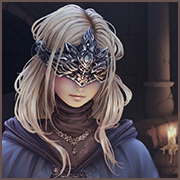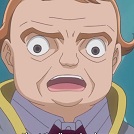|
Got it, and that makes a lot of sense, thank you! I would contend that a lot of water infrastructure only needs to necessarily be there for a rainy season, again, you have places like the Los Angeles River (https://www.google.com/maps/place/L...!4d-118.2231868), where the infrastructure to handle large amounts of water is in place, but the climate is such that said infrastructure is almost always dry. Same with storm drains, and a number of other structures that are only strictly necessary during a storm. I don't disagree with you here, but I do want to point out that a lot of water-related infrastructure is only needed during the worst storms, and isn't necessarily needed for your standard day to day operations. It's also worth noting that some standing water can be explained by rain. We do see rain in Dark Souls 2, for what that's worth. We also see moss and other such things on stone walls that would only really be there if there were rain or other humidity to sustain it.
|
|
|
|

|
| # ? Jun 3, 2024 04:10 |
|
I'm glad it was helpful! I know at times I don't explain things thoroughly enough because I take the assumptions for granted, and that's something I'm trying to work on. Anyway, infrastructure being able to handle a wide range of flow rates is totally a thing. It's also definitely true that, in isolation, some of the examples I listed could have more innocuous explanations. But many of the examples are plainly catastrophic, and then once you take everything as a whole, even the more "this could be plausibly just a low flow period" places would appear part of a broader trend. For example, the Depths of DS1 is probably the place that would best fit somewhere that is rated to handle a greater flow of water but the current rate is within expected trends. But then we consider what's around it. 1. Our entrance to the Undead Burg is through a hole with no door in an aqueduct (possibly blown open by the firebombs the hollows throw at us as we try to enter). Any increased flow would leak out. 2. On the other end of the area, Undead Parish used to have lake that was lost when the outer wall was destroyed. 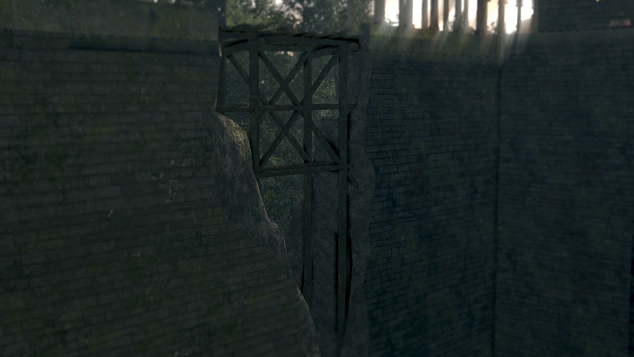 This would help justify why the Altar of Sunlight nearby is so lush. The area used to be watered, and either the change is recent enough for the greenery to not die off yet or that particular altar is being held in magical suspended animation a la Anor Londo while Gwynevere is still 'alive' ("Flow of time is convoluted," blah blah blah) (This structure also happens to be repeated later in the Undead Settlement, where the path to Irina is some sort of river system for the area that drained out) 3. Given the flow leaks on both ends, the fact that Lower Undead Burg is bone dry despite having extensive water flow systems suggests things are worse for the area than a mere dry spell. 4. And if the former water flow systems of Undead Burg + Undead Parish are supposed to empty into the Depths as they appear to, then this could be the root of why Blighttown is, well, a blighted town. Environmental disasters in Undead Burg and Undead Parish cut their incoming water so all that was left is a trickle of polluted run-off from the Butchers' corpse disposal that results in poisonous, standing water. None of the games are explicit about it, but environmental catastrophe is a huge part of the history of these worlds. After all: Aldia posted:Many monarchs have come and gone. One drowned in poison, another succumbed to flame. Still another slumbers in a realm of ice. Not one of them stood here, as you do now. You, conqueror of adversities. Give us your answer. This describes kingdoms succumbing to natural disasters and ecological collapse, which is a really fascinating framework that doesn't really get enough attention.
|
|
|
|
So, this thread is basically now always on my mind when playing Dark Souls, and presently, I'm attempting to get through DS2 (SotFS, so, it's real slow going) Why is this relevant? Because I stumbled across this in the Shrine of Winter: 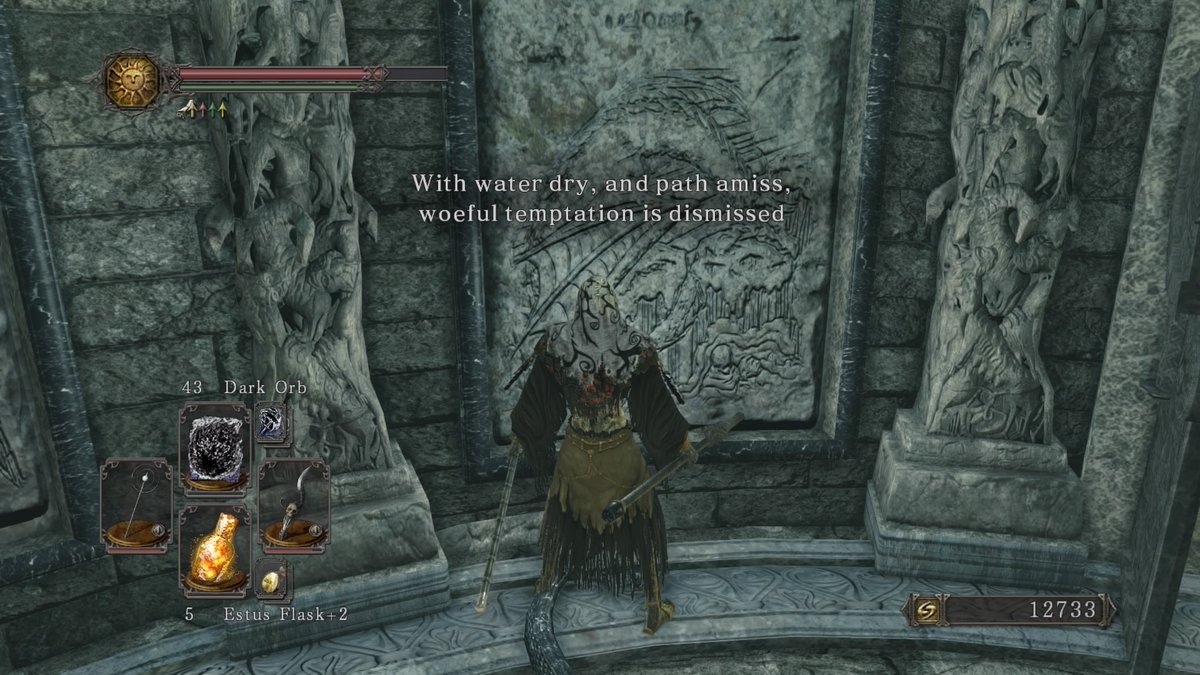 Forbidden is the path to the ancient king's domain With water dry, and path amiss, woefull temptation is dismissed Trespassers will face adversity befitting a monarch Eleum Loyce, land of the Ivory King, lies cold as death, nary a hint of warmth remaining It's interesting that they explicitly mention water drying up in what's supposedly just a "this is a lategame area/the dlc, go away if you're not strong enough" message, huh?
|
|
|
|
If you think that's fun (and it is!), take that theme and run it back to DS2's early game.quote:Many monarchs have come and gone. One drowned in poison, another succumbed to flame. Still another slumbers in a realm of ice. Not one of them stood here, as you do now. You, conqueror of adversities. Give us your answer. These all use water imagery. Specifically, they can be seen as corruptions of a waterfall. --Mytha the Baneful Queen of Harvest Valley is literally a poisonous fountainhead. You shut off the spigot by introducing fire, which immediately leads to --Old Iron King who is literally the embodiment of a volcano. Strictly speaking it's not water, but it's a flowing liquid replacement. Subsequently, it's a thematic corruption of a waterfall as being a source of flowing destruction instead of lifegiving waters. --The realm of ice monarch gets into deeper levels of metaphor than I have the time to get into right now, but the entrance to Eleum Loyce is akin to the source of the waterfall freezing and thereby blocking an entrance. Let's just say the ice metaphor gets complicated But here's the fun bit. For me anyway. This pattern is basically the fight narrative for Sister Friede. She begins as the source of rot for the Painted World of Ariandel. Its baneful queen. You kill her (which creates a tiny river of blood), only for her to be embered back to life by Father Ariandel's lava flow. Finally, in phase 3, she gets her frost scythe and full control over frostbite. Water is everywhere, and it's delightful. ------------------------------------------------------------------------ While I'm here, as a general thread announcement, the Sen's Fortress video is about to come out. I'm maybe refining a new semi-scripted approach to the actual LP content, and I'm curious if it ends up being more watchable as a result. Sibyl Disobedience fucked around with this message at 17:58 on Sep 5, 2020 |
|
|
|
Episode 14 (DS1-07): Where the accepted currency is soulsGold Coin (DS1) posted:Coin made of gold, with Allfather Lloyd and his white halo shown on its face. Copper Coin (DS1) posted:Coin made of copper. Its face shows an image of Old Man McLoyf, god of medicine and drink. Silver Coin (DS1) posted:Coin made of silver, with the portrait of the legendary Knight King Rendal on its face. Ring of Steel Protection (DS1) posted:This ring belonged to the Knight King Rendal. It grants its wearer protection by boosting defense against physical attacks. We’re finally at Sen’s Fortress, the halfway point of sorts for Dark Souls 1. Given that, it seems only appropriate to make this a sort of halfway point to my project, where I can finally start revealing the dark secret I can perceive lurking in the heart of these games. Naturally it revolves around two items the mimic in the area was supposed to drop but that I couldn’t loot because I killed it over an open elevator shaft. 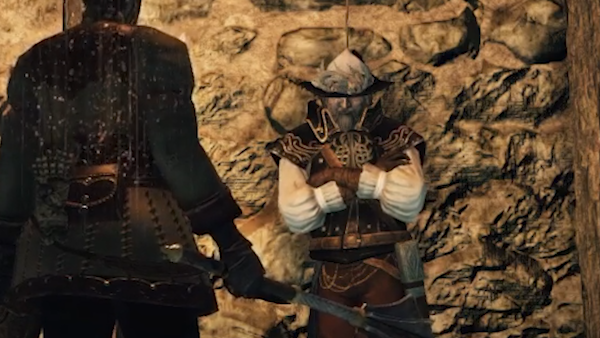 This is Lucatiel. She’s pretty cool and, I suspect, more important to the plot of these games than she appears at first glance. Peculiarly enough, she’s also a reference to Don Quixote. quote:Tanimura: However rearranging the partially completed designs was extremely difficult. For example the character Lucatiel of Mirrah. Her name during development was Don Quixote and the Bell Keeper dwarf her Sancho Panza. They were originally designed as a slightly untrustworthy female knight and her bumbling, middle aged squire much like their namesakes. But while I’m a fan of the source material inserting these two overtly comical characters into such a dark foreboding world just wouldn’t fit at all. So eventually we changed their roles to that of the cursed knight and the Bell Keeper. I simply asked the designers if they could modify them a little for their new roles. Don Quixote isn’t an obvious inspiration for the world of Dark Souls, but one of the ways in which I believe it has influenced the series is that both works of art are metanarratives. met·a·nar·ra·tive /ˈmedəˌnerədiv/ noun 1. a narrative account that experiments with or explores the idea of storytelling, often by drawing attention to its own artificiality. "Don Quixote is a work of fiction but also a metanarrative" 2. an overarching account or interpretation of events and circumstances that provides a pattern or structure for people’s beliefs and gives meaning to their experiences. "traditional religions provide stories that deliver a metanarrative about how we should live our lives" Dark Souls is a metanarrative in the second sense at its very core. In the first game Frampt and Kaathe offer competing narratives about the world the player is travelling through that inform the two choices you’re offered in the ending sequence. Each of them offer a sense of meaning and purpose to the actions that progress the game state, and it’s up to you which path you ultimately choose to follow. But I think Dark Souls is also a metanarrative in the first sense as well. A story about the telling of stories, particularly in the context of integrating myth into video game design. The Painted World of Ariandel in Dark Souls 3 is where this theme is presented most directly. The weapon descriptions for the Corvian items also hint strongly at the power of storytelling itself: Storyteller's Staff (DS3) posted:Staff of a heretic storyteller who shares tales of the Painted World to forlorn souls. I believe these games to be allegorical, stories about their own creation. Take the description of the Copper Coin from Dark Souls 1 that I quoted earlier: quote:Coin made of copper. Its face shows an image of Old Man McLoyf, god of medicine and drink. Old Man McLoyf is a complete mystery. He’s never mentioned anywhere else in the lore and has no obvious connection to any of the existing religious systems in Lordran. This is because he’s a joke. He’s the god of ‘medicine and drink,’ or in other words, drugs and alcohol. When we compare it to the description of the Gold Coin. quote:Coin made of gold, with Allfather Lloyd and his white halo shown on its face. These are the possible outcomes of the game development process. Either you succeed in bringing the world of Allfather Lloyd completely to life, or you just put out a crappy game so you can afford to buy drugs and alcohol back in “the outside world.” But Dark Souls is, as always, properly dialectic, and we’re also given a Silver Coin: quote:Coin made of silver, with the portrait of the legendary Knight King Rendal on its face. What we know about Rendal comes from his Ring of Steel Protection, also found in Sen’s Fortress: quote:Of the many legends surrounding the Knight King Rendal, one of the more well-known speaks of his standing down a giant drake and slashing it to pieces. One of the things Sen’s Fortress Represents is the cutting room floor. 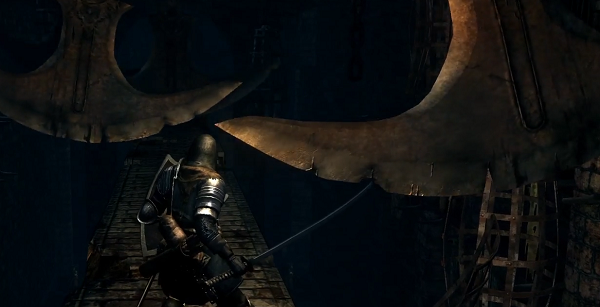 ‘Slashing the giant drake to pieces’ means coming to terms with the fact that Allfather Lloyd’s complete vision is a bit beyond your capability to deliver right now, whether that’s the story of Miazaki’s arrival into what would eventually become Demon’s Souls, or perhaps the decision to divide some original design into what has now become Dark Souls 1 and 2. Some of you might view this line of thought with extreme skepticism. My counter-argument is that these games contain a ton of dangling symbols, themes, characters, and events that don’t neatly fit into the core narrative. If we can weave an explanation that infuses meaning into large swathes of these seemingly hollow signifiers, then we have a reasonably good explanation for why all of these otherwise inexplicable things were included in the game. What they meant to their writer. For instance: [img]https://lpix.org/3845064/acceptedCurrencySplash[small].png[/img] Siegmeyer’s inability to progress into and through the fortress without your assistance is a reflection of the creator’s reticence to allow the Solomon solution to be applied to their child. I first alluded to it way back in episode 2 but Solaire and Siegmeyer symbolize opposite emotion states of the creative process. Solaire is beaming with confidence, which eventually becomes overconfidence leading to his downfall in either path of branching storyline. He even at one point demonstrates a brief bit of self-awareness: quote:But when I peer at the Sun up above, it occurs to me… Solaire is a project manager who still believes that the golden vision of Allfather Lloyd is within his grasp, and Siegmeyer is an individual struggling with the reality that the silver medal is the best he can do right now. None of this means that it is illegitimate to read Solaire’s and Siegmeyer’s stories as a standalone narrative, but seeing their dual existence as an allegory provides a better understanding of the environment that informed their creation. That their stories of, quite frankly, depression resonate so strongly because they’re a reflection of real, personal struggles. Like I said, my evidence for this metanarrative interpretation is how it provides meaning to otherwise incoherent moments in the game world. Take, for example, the character of Undead Prince Ricard who we encounter at the very top of Sen’s.  We know very little about the character, other than that his armor appears to be Astoran and what the Ricard’s Rapier he drops tells us: quote:A rapier with intricate decorations. Chosen weapon of the famous Undead Prince Ricard. Ricard's exploits are told in a monomyth. But the most fascinating detail about the character is the environment he inhabits. He appears to be guarding two chests, containing a Divine Blessing and a Rare Ring of Sacrifice: 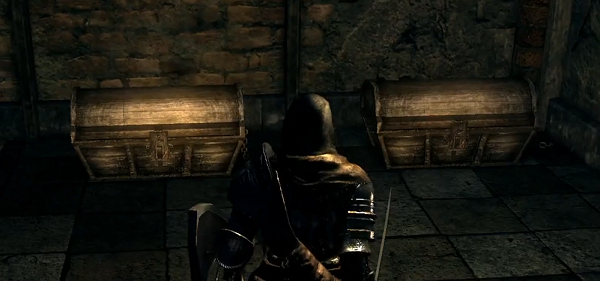 Divine Blessing (DS1) posted:Holy water from Goddess Gwynevere. Fully restore HP and undo irregularities. Rare Ring of Sacrifice (DS1) posted:This mystical ring was created in a sacrificial rite of Velka, the Goddess of Sin. But on a symbolic level, he’s not guarding these chests; he’s choosing between them. A choice between two goddesses to serve. A choice between the light and the dark. Between sunlight or sin. And given that the Divine Blessing despite its description does not cure curses, between staying cursed or being freed of it. My personal interpretation is this represents having to make a choice between finishing, as it was originally intended, the project that has now become Dark Souls, or betraying it to work on some other new opportunity. As to what that other goddess might possibly represent, consider that at the very bottom of Sen’s among all of the titanite demons we loot a scythe that is not a scythe. Scythe (DS1) posted:Halberd with a large blade. As many have already pointed out, the graphic for this weapon is actually a bardiche. Despite the developers naming it Scythe, the item description is aware that it is not a scythe, declaring it to be a “halberd” that was originally a scythe but was “adjusted for battle.” This highlights a narrative where the essential theme was one of being converted from one form to another, which kinda makes it sound like a Trick Weapon from Bloodborne. And it would specifically be one that originates as a Scythe, a tool for farming, that has been converted into a weapon that can be used for executions, which ought to be ringing some bells. Anyway, other things happened in Sen’s, but this is the bit I personally care about the most right now. The rest can be discussed when we have later zones to compare it to. I do just want to close with the idea that the Man-serpents might not be indigenous to the area. One of the interesting things is how much more vulnerable they are to the traps during the intro, such as setting off the blowdart pressure plates in ways that get them killed or regularly finding themselves in the path of the boulders. Once you pass through the fog gate, they learn to position themselves in a way that complements the trap positions much better. I’m also inclined to see the fog gate as some sort of chronological progression since the direction the boulder trap is oriented seems to shift whenever you approach the original location of the fog gate, regardless of what you’ve personally set it to. Perhaps it was originally something to keep the Man-serpents out, but that they eventually learned to manipulate for their own purposes.   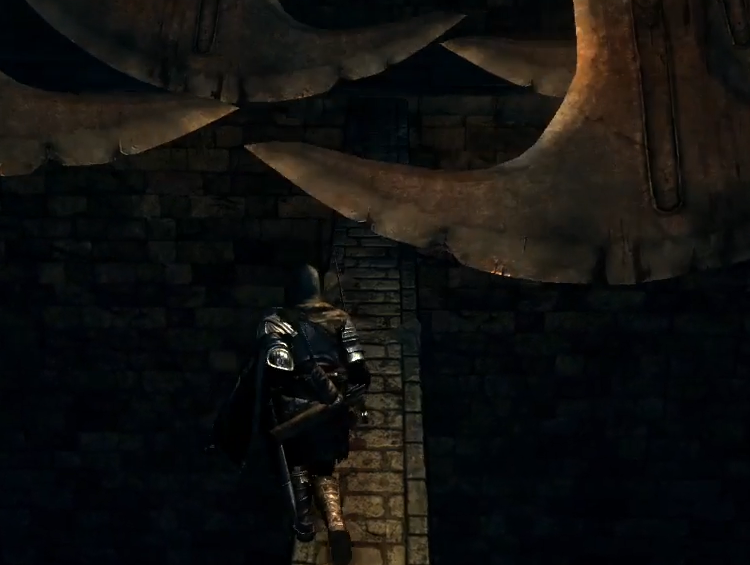 One last space-time oddity found in the zone progression is the guillotine pathways themselves. There’s a distinct feeling of increased claustrophobia in the pendulum sections as you progress through the zone, almost as if your sense or perspective relative to the architecture enlarges past the fog gate. Maybe it’s just purely a game mechanic decision to heighten the stakes as you progress, but given some of the other spatial oddities throughout the series, I can’t help but wonder if something more is going on at a narrative level. Either way, it’s a neat environmental detail.
|
|
|
|
Just a small update. I think I am going to discontinue the area videos for the moment. They're honestly a bit of a chore to make, and the energy I put into them I'd rather be directed towards the scripted video stuff like the Friede/Priscilla video and the Blighttown video. This is especially true now that we're approaching the exciting parts (for me anyway), because I end up procrastinating out of the desire to just jump ahead. I will still play through the areas in a linear fashion and do the text+screenshot because they're really helpful for me and comparatively a breeze. The videos themselves are just stuck in this uncanny valley between being a playthrough and being an essay, and ultimately too divided in purpose to reliably satisfy either audience.
|
|
|
|
Episode 15 (DS3-04): The Riddle of the Inscrutable Liftquote:Hmm... Mmm... [img]https://lpix.org/3848636/undeadSettlementInspiration[Small].jpg[/img] This might seem weird to most experienced Souls players, but I think Undead Settlement is one of the most fascinating areas in all of the games. There’s a plethora of storylines and connections lurking in this zone, so many that I’ve decided to split it and its short following area the Road of Sacrifices into three different episodes. To try and keep things easier to follow, I’m going to focus on only three of the major plotlines here and save everything else for future episodes. The Sable Church of Londor Immediately upon entering the area, we run into more of the Pilgrims we saw earlier at the bottom of the High Wall of Lothric. 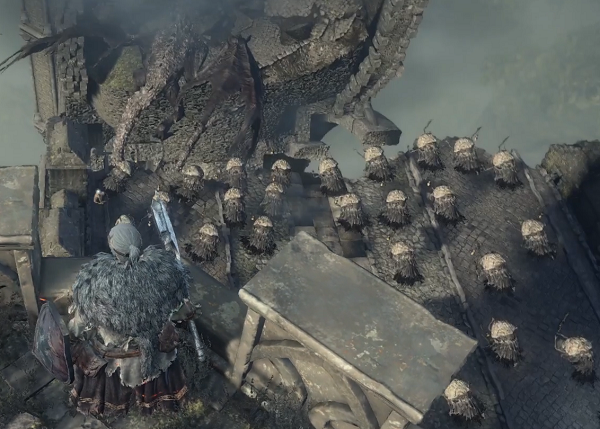 Their path to Lothric appears to have been blocked by the death of a dragon, and they simply died with their quest unfulfilled. That is, except for one by the name of Yoel, who somehow “failed to die as was ordained.” He perks up considerably once he runs into the player, declaring us the Champion of Ash and pledging himself to our service. There’s a whole tedious questline that appropriately enough involves dying a lot, and subsequently Yoel is released of his shackles, bringing Yuria and her Sable Church into our life. So I know this is shocking and unheard of lore theory, but Londor is New Londo from DS1. Well, technically speaking I consider it a ‘resettling’ or a thematic reincarnation, but let’s not get hung up by the jargon of symbolic multiverse theory. In short, we know that Yuria is in service to Kaathe, as her dying line is “Kaathe, I have failed thee…”, and Kaathe is a resident of New Londo (more or less). Yuria also sells us the Dark Hand, the weapon of the Darkwraiths we find in New Londo, “an ancient relic of a Primordial Serpent.” Finally, there’s like a letter difference, I mean come on. Don’t get hung up on the technicalities of the precise time/space connection between Lordran and Lothric right now. What’s certain is that Londor and New Londo obviously have a connection on a thematic level, and deciphering that connection will allow us to work backwards to the mundane lineages of temporal reality. For me, the most interesting connection is the connection they share to Vinheim. Yoel tells us that “the magic of Londor is a far cry from the wonders of Vinheim,” suggesting that he has been to Vinheim. The Magic Weapon and Magic Shield spells that he sells are also described as deriving from Vinheim. This all is relevant to New Londo because if you’ll recall, the merchant smith of New Londo ruins was the imprisoned Rickert of Vinheim, who in that game sells the two other spells that Yoel initially has available for sale. So again, not worrying about the linearly temporal history in lands as convoluted as these, I’m going to suggest that the goal of (some subset of) the Vinheim Dragon School is the ascension of humanity to dragons, a parallel to the desire of characters like Willem and Imposter Iosefka to ascend to kin. This is also a narrative hinted at in Consumed King Oceiros, the Drakeblood armor set, and recurring items like the Dragon Head Statue. I believe that Yoel and the pilgrims of Londor took part in a similar if not identical quest to ascend to dragonhood, one that left them as only a pale imitation of their goal. This explains the symbolic similarities between the design of the Pilgrims and the Serpent-men of Archdragon Peak, specifically the headwrap over an elongated neck and the hunchback aspect to both models. For whatever it’s worth, the Serpent-men use the small leather shield we find shortly after we leave Yoel and enter the Undead Settlement proper. And as we saw in the last episode, Vinheim in Dark Souls 1 is also heavily tied to the first appearance of the Man-serpents in Sen’s Fortress. 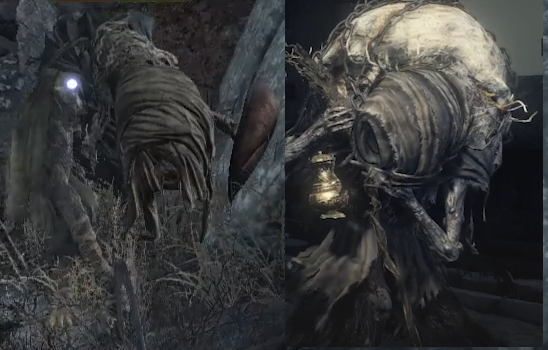 My rough belief at this point is that the Pilgrims of Londor are the sorcerers of Vinheim in some timeline whose wills have been hijacked by the Sable Church. The shackles Yoel speaks of are literally visible on his back. That white shell is effectively a fungal infestation similar to the cordyceps that enslaves the former Vinheim sorcerers on a journey to the highest branch in the world, the top of Lothric Castle. Yuria’s future animosity towards Orbeck of Vinheim stems from him being a practitioner of the Vinheim school who still operates outside of her control. From Mayor to Guardian For me, the real star of the Undead Settlement is Siegward, because the evolution from Siegmeyer in Dark Souls 1 to Siegward in Dark Souls 3 is one of the most uplifting stories in the series. In Sen’s Fortress we run into Siegmeyer two different times. Both times, he is incapable of progressing without your assistance.  It becomes a running theme throughout the game, repeated in Anor Londo, Blighttown, and then finally Lost Izalith, that Siegmeyer cannot accomplish anything on his own. Not only that, he cannot meaningfully cooperate with you in getting around his obstacles. He is completely and utterly helpless. In Dark Souls 3, we have Siegward instead who provides a subtle but inspirational twist on Siegmeyer’s storyline. 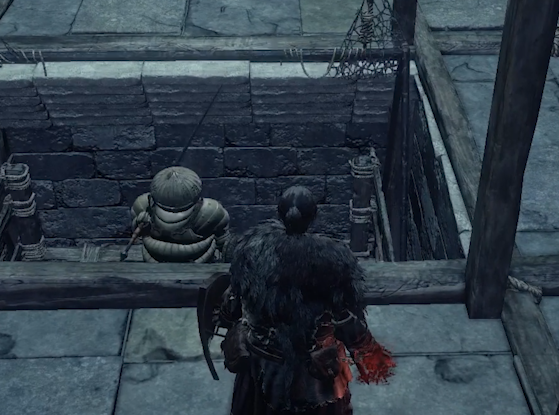 When we first talk to Siegward, he has a problem: To be honest, I'm in a bit of a pickle. Have you ever walked near a white birch, only to be struck by a great arrow? Well, if I'm not mistaken, they come from this tower. Whoever it is, I'm sure I can talk some sense into them. But I have to find a way up, and that's just the trouble. This lift only goes down, you see, and... Well, that doesn't get me anywhere... Hmm... Mmm... Luckily, because we watched Siegward’s arrival, we can discover that the solution of the riddle is that there is a second elevator platform above the one that Siegward arrived on.  We can then take the lift up and talk to the archer that Siegward was referring to. On the way back down, we hear Siegward’s distinctive “Hmm…” and notice a lamp, leading to an area disconnected from the rest of the map.  Hmm... Mmm... Ah, oh! Don't disappear like that. You had me downright worried. But thanks to you, an epiphany has struck me sqaure in the head. I've unravelled the riddle of this inscrutable lift! Unlike the questline in Dark Souls 1 where we only help Siegmeyer throughout the game, here you and Siegward are learning by watching each other progress. It’s essentially the same idea behind player bloodstains and orange soapstone messages. When we arrive, Siegward has stumbled upon yet another obstacle:\ quote:Anyhow, do you see that? That humungous beast. Similar to Siegmeyer, Siegward is cautious to a fault. Luckily for him, you are there to be appropriately impulsive. quote:No! You should have waited! This is, in many ways, the culmination of the Siegmeyer vs Solaire dialectic I mentioned way back in the Undead Parish during episode two. Siegmeyer represents the way caution can become cowardice, and Solaire represents the way bravery can become recklessness. But here, with you playing the role of Solaire, you each serve as a check for the pitfalls of the others’ personality, and subsequently work better as a team than, say, a brash knight charging ahead far more quickly than his lumbering companion is capable of keeping up with. Appropriately, this interaction even ends with Siegmeyer cribbing a bit off of Solaire’s style. 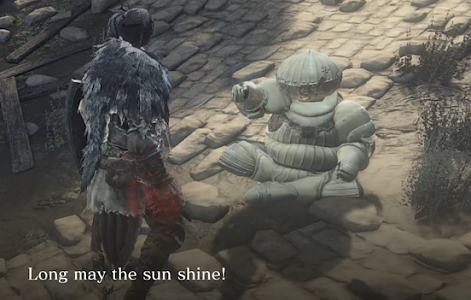 Hints of Dark Souls 2 While that was the story I most wanted to focus on, I feel like I should mention that after helping Siegward fight his demons, the extremely optional area we explore has a couple explicit Dark Souls 2 references that warrant attention. The first is the Northern Armor Set. While the graphical similarity is probably most similar to Benhart’s Set, its description and the surrounding environment recalls the Varangians from Dark Souls 2. Both of the described races hail from the north, but more importantly, one of the implicit storylines of both the Undead Settlement and the Road of Sacrifices involve the signs of slave transportation, similar to the storylines of No Man’s Wharf and the Lost Bastille. Additionally, as we exit the area we get a far more explicit reference in the Mirrah Set, a not so subtle reference to Lucatiel of Mirrah from Dark Souls 2. But it doesn’t end there as the soul of the nearby Curse Rotted Greatwood gets you her sword: quote:Greatsword used for a lifetime by a masked knight. Harbors the fears that lurk within the mind of Hollows, and is particularly effective against them. And a defeat of Hodrick who lurks in the same area nets you a Vertebrae Shackle, which can be traded to Pickle-Pee to obtain her mask. So yeah, this area has some extremely important ties to the lore of Dark Souls 2, but going any further down that road will have to wait a few more episodes. In the meanwhile, I’ll leave you with one last hint at the Dark Souls 2 connection that we find in the area. Eygon of Carim posted:If like the others, you’re fool enough to play the champion… Dark Souls 2 Opening posted:Like a moth drawn to a flame.
|
|
|
|
Will write some more comments later, but this here...Sibyl Disobedience posted:--Mytha the Baneful Queen of Harvest Valley is literally a poisonous fountainhead.
|
|
|
|
Carpator Diei posted:...is particularly interesting to me because it just never occurred to me to interpret the "drowned in poison" line as referring to Mytha, even though it fits perfectly; I just automatically assumed that it's about the Sunken King. Mytha is quite a curious character in general; her story as found in the lore is rather tangential to the "main plot" of the Old Iron King's downfall, but on a thematic level she establishes quite a close connection between the Iron King and the Sunken King (I somehow only just now realized the blatant parallelism between the names 'Mytha, the Baneful Queen' and 'Elana, the Squalid Queen', which seems to be a very intentional connection considering that Mytha isn't even a "real" queen in the sense of being the wife of a king – though she does fit into the general theme of queens and princesses ruling in stead of an absent king). Yep. It's a section that is at face value kind of bizarre to both the storyline of Elana and the non-DLC plot of Drangleic as a whole. We already have four presumed Sisters of Dark, yet here's this unattached fifth queen. Though to be thorough, nothing about Alsanna is coded as a queen in as traditional sense as the other 3 + Mytha, and I'm inclined to read her as an adopted daughter who inherits the kingdom rather than a queen. In an interesting, semi-related tidbit, the game's description quote:The old one of the Abyss was reborn in death, is deliberately ambiguous on whether it was the monarch or the power that "they desired to make their own." Anyway, people tend to read the whole "drowned in poison, succumbed to flame, slumbers in a realm of ice" thing as both fairly literal and as descriptions pointing to singular events, but in Mytha and Elana we have two different queens that could fulfill the "drowned in poison" step of the prophecy. On a purely symbolic level this could be a way of reinterpreting the same archetype, but on a more literal narrative level this could mean that the poison->flame->ice cycle is a cycle of eternal return. If that's the case, then maybe the Ivory King and Eleum Loyce isn't the only possible referant for the realm of ice. Following that line of thought, let's try to separate it into DLC mythos and non-DLC mythos. In the non-DLC we have Mytha completing "drowned in poison," and in zone that immediately follows her defeat we have the Old Iron King literally succumbing to flame. Following the in-game teleportation list, what's the next encounter would best convey the concept of a frozen monarch? 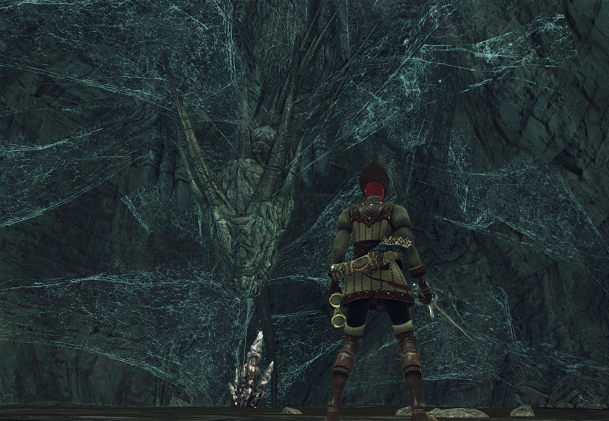 And to push things just a bit further, if you remember the end of Brightstone Tseldora, a few rooms earlier we come across something that looks extremely similar to this: 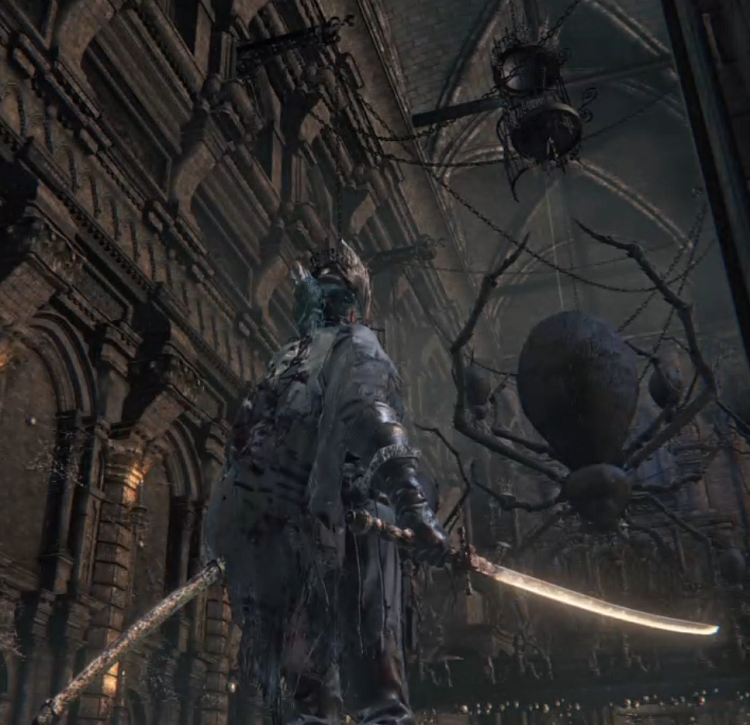 And for now, let's just say that a thematic connection between Tseldora and the Nightmare of Mensis leads to some very interesting places.
|
|
|
|
About metanarratives: One rather fascinating aspects of the FromSoft games is that for all the metatextual reflection on their own status as produced works of art that you're uncovering here (and I'd say that at the very least in the painted worlds that metatextuality is extremely important), recognizing that meta-layer is not strictly necessary to get something out of these games (and I don't just mean enjoyable gameplay). If anything, having the games constantly keep their unrealized former possibilities present in some way might contribute a lot to their intricate and focused, yet unclosed semantic structure. It actually ends up preventing them from only referring to themselves all the time, which can happen pretty quickly when meta-narratives are involved. For instance, the water symbolism can be connected to so many other themes, not least to light and dark and all their possible interpretations relating to society, nature or the psyche.Sibyl Disobedience posted:That their stories of, quite frankly, depression resonate so strongly because they're a reflection of real, personal struggles. And then there's the Dark Souls III DLCs where artistic creation and its relationship to the hegemonic light-dark dichotomy becomes an explicit surface-level plot point. You'll probably get to that, but the Painting Woman's description of her new painted world as "a cold, dark, and very gentle place" does seem to indicate that the escape from the endless cycle lies on the side of the dark, but a "reclaimed" dark of sorts, one that is consciously shaped after the needs and wants of the people living within it – after all, a lot could be said about the Dark in the Souls series, but it is never close to anything I'd call "gentle". Though now that I think about it, deep still water could certainly be described as cold, dark and gentle.
|
|
|
|
Carpator Diei posted:About metanarratives: One rather fascinating aspects of the FromSoft games is that for all the metatextual reflection on their own status as produced works of art that you're uncovering here (and I'd say that at the very least in the painted worlds that metatextuality is extremely important), recognizing that meta-layer is not strictly necessary to get something out of these games (and I don't just mean enjoyable gameplay). If anything, having the games constantly keep their unrealized former possibilities present in some way might contribute a lot to their intricate and focused, yet unclosed semantic structure. It actually ends up preventing them from only referring to themselves all the time, which can happen pretty quickly when meta-narratives are involved. For instance, the water symbolism can be connected to so many other themes, not least to light and dark and all their possible interpretations relating to society, nature or the psyche. Yeah, the abstraction level they're using is so extensive that it's almost impossible to notice despite being kinda blatant once you know what to look for. I think that's for the best though. You focused on how meta effects the writers, but I think the audience can often treat anything with a metanarrative as less real (despite being more real by definition) because the suspension of disbelief is harder to maintain if you're immediately aware of an interpretive layer that is more real than the one you're operating in. I think Dark Souls' approach is ultimately a lot more effective. It certainly made me a lot more sympathetic towards Friede. Carpator Diei posted:And then there's the Dark Souls III DLCs where artistic creation and its relationship to the hegemonic light-dark dichotomy becomes an explicit surface-level plot point. You'll probably get to that, but the Painting Woman's description of her new painted world as "a cold, dark, and very gentle place" does seem to indicate that the escape from the endless cycle lies on the side of the dark, but a "reclaimed" dark of sorts, one that is consciously shaped after the needs and wants of the people living within it – after all, a lot could be said about the Dark in the Souls series, but it is never close to anything I'd call "gentle". Though now that I think about it, deep still water could certainly be described as cold, dark and gentle. Ok, so, I'll jump ahead because it's topical and I really like this bit. Also in the Painted World of Ariandel, we have the Corvian Settler who has this line of dialogue. quote:When the world rots, we set it afire. Compare to: https://www.gamespot.com/articles/dark-souls-3-interview-it-wouldnt-be-right-to-cont/1100-6432425/ Miyazaki posted:I don't think it'd be the right choice to continue indefinitely creating Souls and Bloodborne games. I'm considering Dark Souls 3 to be the big closure on the series. That's not just limited to me, but From Software and myself together want to aggressively make new things in the future. Dark Souls 3 will mark the last game where the development project began before I became president. The next title will be a game that was conceived while I was president. I believe that From Software has to create new things. There will be new types of games coming from us, and Dark Souls 3 is an important marker in the evolution of From Software. An interpretation of the Usurpation of Fire ending is that the Sable Church is Bandai Namco going ahead and making Dark Souls 4 without FromSoft's approval. Afterall, we have sentiments like this one, so I don't think it's that big of a stretch: https://twitter.com/itsExari/status/1302316368570843136 That's part of why I believe End of Fire is the "correct" ending. It let's Dark Souls 3 be what it's intended to be: an inverted funeral pyre. It's an exercise in moving past their regrets and letting go of the past. And it's painful, even if they're 100% certain it's the right thing to do. As my imagesake puts it: quote:The First Flame quickly fades. It's simultaneously the most hopeful moment I've encountered in video games and also the most crushing. And it's truthfully really beautiful.
|
|
|
|
oh yeah, the metanarratives of DS3 (and the second DLC) can very easily tie "the age of fire" to "dark souls as a franchise" the constant prolonging of the world, constantly trying to stave off the inevitable -> "we've made the games. they're good games, but it's time to do something completely new, otherwise we'll just end up rehashing things over and over again" the deliberate callbacks are equal parts fanservice and fromsoft going "look, we can only re-use this stuff so many times before it starts getting stale, okay?"
|
|
|
|
It's even a step further than that. This probably sounds weird, but according to the rules they set up they're only allowed to to re-use stuff. They can reinterpret the past, but can't really add to it. Take your incredibly insightful description quote:the constant prolonging of the world, constantly trying to stave off the inevitable and transpose it into this: quote:"Demon's Souls wasn't doing well," Miyazaki told Simon Parkin during a profile interview for The Guardian. "The project had problems and the team had been unable to create a compelling prototype. But when I heard it was a fantasy-action role-playing game, I was excited. I figured if I could find a way to take control of the game, I could turn it into anything I wanted. Best of all, if my ideas failed, nobody would care - it was already a failure." They're not rehashing the games they've made; they're rehashing the games they couldn't. Every Great One loses its child...
|
|
|
|
Sorry for the delay. I've been wrapped up in making a new scripted video for the summary of age 2, which revolves around hunger, the Late Bronze Age Collapse, and the Wild Hunt. Things are going faster than usual, but also slower than I would like, in part because it requires me to actually start doing DS2 recordings. In other news, I'm kinda frustrated by the state of lore discourse on reddit. The major Dark Souls subreddits are somewhere between mostly indifferent and hostile to lore talk, but there doesn't seem to be any other public discussion sites for Dark Souls at this point in its life cycle. This guy in particular is posting some fascinating stuff and receiving only hostility over it. It's extremely discouraging that the only type of lore speculation I find interesting anymore only gets ignored and downvoted. Maybe we are just abominations with no place in this world.
|
|
|
|
Speaking of missing water, is there ocean in any of the FromSoft games? It'd be odd if it weren't in Sekiro, at least. If you don't mind me nerding out a bit, the ocean is both what gives Japan life (its rich aquatic resources) and protection (most notably with the "divine winds" that sank the Mongol fleets) but also death (storms and tsunami) and isolation (Japan being an island was what made forbidding people to come in and out of the country even possible during the Tokugawa shogunate). The ancient Greeks have a similarly ambivalent relationship with the ocean--they saw it as the primordial chaos: the source of all life but also the very edges of the known world. For the Chinese, who tended to be far less adventurous than the Greeks (barring very few exceptions), saw the ocean as a point of no return: all of the great rivers of China run east into the ocean, and as far as the common man was concerned, that water wasn't coming back (in Chinese mythology, rain came from the heavens and were managed by dragons). The Jews, who were not sailors like the Greeks, thought of the seas as chaos without any of the potential upsides: in Exodus, being pinned against the Red Sea was pretty much a death sentence, Heaven is described as having sapphire-like oceans (and in the world to come the sea "is no more" at all!), and it's not for nothing that the great beast of the apocalypse rises from the seas. The repeating motif of missing water also reminds me quite a bit of the version of Ben Hur starring Charles Heston--Ben Hur meets Christ (who gives him a drink), as a rowing slave Ben is surrounded by water he can't drink and would surely kill him if he fell in (and indeed he almost drowns when the ship is attacked), the Hur household fountains have dried up in the devastation that befell their household, Ben Hur himself complains of a thirst he can't quite seem to quell, and a great rainstorm falls as Christ is crucified that heals the Hur sisters of leprosy. I haven't read the book or seen the other versions so I don't know if that's something that was always there in the original work or common across all versions, and it's been a very long time since I saw the stage version so I only recall the general plot outline and none of the staging details (except that they staged the Sermon of the Mount in parallel with Ben Hur's revenge quest training montage) dotchan fucked around with this message at 06:30 on Sep 29, 2020 |
|
|
|
dotchan posted:Speaking of missing water, is there ocean in any of the FromSoft games? It'd be odd if it weren't in Sekiro, at least. If you don't mind me nerding out a bit, the ocean is both what gives Japan life (its rich aquatic resources) and protection (most notably with the "divine winds" that sank the Mongol fleets) but also death (storms and tsunami) and isolation (Japan being an island was what made forbidding people to come in and out of the country even possible during the Tokugawa shogunate). The ancient Greeks have a similarly ambivalent relationship with the ocean--they saw it as the primordial chaos: the source of all life but also the very edges of the known world. For the Chinese, who tended to be far less adventurous than the Greeks (barring very few exceptions), saw the ocean as a point of no return: all of the great rivers of China run east into the ocean, and as far as the common man was concerned, that water wasn't coming back (in Chinese mythology, rain came from the heavens and were managed by dragons). The Jews, who were not sailors like the Greeks, thought of the seas as chaos without any of the potential upsides: in Exodus, being pinned against the Red Sea was pretty much a death sentence, Heaven is described as having sapphire-like oceans (and in the world to come the sea "is no more" at all!), and it's not for nothing that the great beast of the apocalypse rises from the seas. For a certain definition of it, the "Ocean" is a critical motif in Bloodborne. As Sybil has pointed out through the Bloodborne videos, no physical water, though.
|
|
|
|
dotchan posted:Speaking of missing water, is there ocean in any of the FromSoft games? Dark Souls 2 has a few areas set at the sea coast, and one on an island. Ash Lake might also be interpreted as an ocean. Interestingly enough, Sekiro's game world is probably the one farthest from any oceans (Ashina is explicitly a mountainous region, almost as isolated from the rest of Japan as Japan is from the mainland), but also the one that's most explicitly about water – water that's coming from a dragon, in fact. Carpator Diei fucked around with this message at 14:37 on Sep 22, 2020 |
|
|
|
dotchan posted:Speaking of missing water, is there ocean in any of the FromSoft games? It'd be odd if it weren't in Sekiro, at least. If you don't mind me nerding out a bit, the ocean is both what gives Japan life (its rich aquatic resources) and protection (most notably with the "divine winds" that sank the Mongol fleets) but also death (storms and tsunami) and isolation (Japan being an island was what made forbidding people to come in and out of the country even possible during the Tokugawa shogunate). What kind of body of water the Fishing Hamlet is next to is left vague. Given the runes in the game, I'm inclined to see it as both a lake and a sea, depending on the phase of reality that it's currently situated in. I don't think there's any indication of whether or not it would be a landlocked sea. In DS3, you can also see something that looks vaguely oceanic off in the distance past Farron and the Cathedral of the Deep. As Carpator pointed out, DS2 has the most distinctly oceanic coded stretch from Majula -> Heide's Tower of Flame -> No Man's Wharf -> Lost Bastille -> Sinners' Rise. Each subsequent Great Soul route pushes the water farther away, as seen in the river depictions in Huntsman's Copse and then Shaded Woods. In fact, the concept art for Harvest Valley has the area inundated by a huge waterfall structure, which gets alluded to in the Design Works interview: quote:Stake: Originally the entire map was like a basin completely filled with poisonous fog. In the first design you would redirect the flow of water to start the windmills and that would clear the fog away. Of course that changed in the final game but I think ultimately it became a visually interesting location. And Brightstone Cove Tseldora is described as a "cove" despite having no water whatsoever. And by the time we get to Drangleic Castle we're back to the purely mountainous imagery of Firelink, Lothric, and Ashina. So anyway, you mentioned tsunamis, so let's talk about Majula. quote:Satake: Yes, it’s the starting point for all of your adventures but it’s also somewhere you spend a great deal of time. There is a heroine like character in the Emerald Herald and other NPCs also gather as the game progresses so it serves a huge number of functions and we had to figure out how to represent those in the environment. I think the map designers had a tough job incorporating all of those components. They describe this as purely in non-narrative terms, but was it? The worlds of Dark Souls are full of implied environmental catastrophes, so when we see the next area we go to off in the distance:  I'm inclined to interpret it as the time frozen remnants of the that lower half prior to its destruction (by, say, a tsunami). This double layered Majula also has concept art:  and  Notice how they feel almost like a before-and-after, with the second one looking honestly a lot like the Fishing Hamlet (an area that is distinctly divided into upper and lower sections much like Majula was originally intended to be). In 1700, a massive earthquake struck the Pacific Northwest. The Native Americans at the time kept oral records of its destruction, but these weren't taken seriously until scientists started uncovering physical evidence of the destruction. One example is the Ghost Forest of Copalis, Washington. The tsunami created by the earthquake flooded the forest with salt water, resulting in groves of dead trees, similar to the setup we see in Ash Lake. We also have a set of Native American mythology revolving around earthquakes and tsunamis. Of particular interest to us is that these earthquakes are often attributed to double-headed serpents: quote:The Quileute people of western Washington know a similar dangerous entity, the "T´abale", and the Kwakwaka'wakw (or Kwakiutl) of Vancouver Island tell stories about the double-headed water serpent "Sisutl", which apart shaking the earth would also capture the souls of the people. We even have a Sekiro parallel! quote:According to a popular Japanese myth the cause of earthquakes is the giant fish Namazu, often depicted as a giant catfish in woodcuts called namazu-e. He is considered one of the yo-kai, creatures of mythology and folklore causing misfortune and disasters. Only the god Kashima can immobilize namazu and with the help of a heavy capstone he will push the fish against the foundations of earth. However the god sometimes got tired or is distracted from his duty, Namazu will use these moments to wiggle his tail, causing an earthquake in the human world. Anyway, one of the particularly interesting Tsunami myths I stumbled upon was this one from the Tolowa people in Northern California: quote:One autumn, the earth shook, and the water began rising. People began running, and when the water reached them, they turned into snakes. because it's extremely reminiscent of the second half of the Forbidden Woods in Bloodborne where people are literally turning into snakes. And as a Madman's Knowledge helpfully points out, the backs of the tombstones in this area appear to have experienced water damage, like the kind you might see after a Tsunami. One other earthquake/tsunami myth involves the Thunderbird and the Whale: quote:Whale was a monster, killing other whales and depriving the Quileute tribe of meat and oil. Thunderbird, a benevolent supernatural being, saw from its home high in the mountains that the people were starving. It soared out over the coastal waters, then plunged into the ocean and seized Whale. A struggle ensued; the ocean receded and rose again. Many canoes were flung into trees and many people were killed. Thunderbird eventually succeeded in lifting Whale out of the ocean, carrying it high into the air and then dropping it. Then another great battle occurred on the land. Ok, so, disclaimer. If I ever say "So and so is X," that only means that in one instance a particular character can be seen as a metaphor for x. Like the Greeks, FromSoft games are ambivalent about a lot of things, and so we get a lot of conflicting symbolism about singular characters. Because whether something is a blessing or a curse kinda depends on your perspective. For all the talk of the curse of the undead, Solaire is pretty stoked about becoming one. Anyway, Kos is the whale. The shipwrecks surrounding the cove of the Orphan of Kos arena? It's a Moby Dick reference. The central pillar of game concept that was captain Ahab's curious mania. A bloated prototype that was absorbing all the resources and leaving the tribe starved of meat and oil. The earthquake was her sacrifice, the Thunderbird dropping her back to the earth as depicted in the falling snail woman in the Hunter's Nightmare near where you get the Whirligig Saw. Which would incidentally be an ideal took for breaking open a shell and fragmenting her soul in order to create humanity. Kos is also Tiamat: The Sacred and the Profane posted:As we shall see later, the dragon is the paradigmatic figure of the marine monster, of the primordial snake, symbol of the cosmic waters, of darkness, night, and death-in short, of the amorphous and virtual, of everything that has not yet acquired a "form." The dragon must be conquered and cut to pieces by the gods so that the cosmos may come to birth. It was from the body of the marine monster Tiamat that Marduk fashioned the world. quote:Slicing Tiamat in half, he made from her ribs the vault of heaven and earth. Her weeping eyes became the sources of the Tigris and the Euphrates, The weeping eyes is both the origin of Caitha, the goddess of tears, as well as the Divine Dragon in Sekiro. And as for the ribs... https://illusorywall.tumblr.com/tagged/dark-souls-2  And with the conclusion of Bloodborne's DLC, you're finally laying her soul to rest. Probably to be reborn, knowing how FromSoft works. quote:Curse the fiends, their children too,
|
|
|
|
https://www.youtube.com/watch?v=y4_WKF-pg8s Internal reviews have been less positive than hoped, but they can't all be coherent. Voice might suck because the air quality during recording was atrocious, and I haven't been feeling good in general. I'm just going to cut my losses and move on. I'm considering changing my plans at this point and making the next stretch blunt and embellished, so we'll see how that goes.
|
|
|
|
Episode 16 (DS3-05): The Transposing KilnWarmth (DS3) posted:Peculiar pyromancy of the Mound-makers. Creates a gentle flame that restores HP on touch. Holy Knight Hodrick (DS3) posted:Beware, the shackles of the Gods are fragile. You might need this. Etch it on your heart if you feel your sanity slipping. The Undead Settlement of Dark Souls 3 has a very peculiar storyline. The arboreal plague we first saw in the High Wall of Lothric appears to have progressed further in this area as evidenced by these transformed bodies often, but not always, found in rocking chairs.   A similar design is repeated later in the tree skeletons found below the sewers  And it’s possible that the purpose of the peculiarly-shaped thrall hoods is to conceal vine-like growths  So if we’re treating the storyline of this zone like a forensic puzzle, we’re going to have to make some informed assumptions based on seeking connections between the evidence we’re presented in-game. We then test these assumptions by creating a narrative from them and seeing if it “plugs in” to our broader understanding of the games. Assumption #1: The Curse-rotted Greatwood is the root of the plague Why else would it be here? This would seem to implicate Hodrick and the Mound-makers as the creator of the Greatwood and the curse, which is equally believable. Assumption #2: The Caged Hollows are Hodrick’s creation This is why Hodrick’s area is full of cages  As a mad phantom, Hodrick goes out and kills a bunch of hollows, brings them back to his lair, and puts a bunch of them into a cage to create a new creature. Note that the Caged Hollows can throw an orange blob similar to a Dung Pie but with no toxic application. That’s because the status effect they’re actually trying to apply is the equipment deterioration from the previous games like the Gaping Dragon’s liquid ooze in DS1 or the disposal chute in Aldia’s Keep in DS2. The Curse-rotted Greatwood exudes the same orangish liquid during its fight, and the catch is that unlike the previous games the player is now immune to that form of equipment degradation. This effectively makes the Caged Hollows kinda like mushrooms. A new creature created from the decomposition of the rot of the dead. But maybe it’s incorrect to assume that Hodrick is responsible for making the Caged Hollows. Hodrick’s cages narrow at the bottom whereas the Caged Hollows stay perfectly cylindrical and are nowhere to be seen in Hodrick’s area. It could be that the two forms of cages are an input/output process, but if so, I have no sense of where the perfectly cylindrical cages enter the picture. Assumption #3: Some denizens of the settlement do not like the tree curse My belief is that the Evangelists are here to oppose the religious system that has sprung up around the Curse-Rotted Greatwood.  The two spells they cast, Gnaw and Sacred Flame, would be perfect for removing vegetative growths from their followers, and the related item descriptions talk about cleansing impurities. Sacred Flame (DS3) posted:Pyromancy taught among savages. Flame burrows inside foes and ignites. Red Bug Pellet (DS3) posted:Medicinal pellet made from crushed insects. The red type temporarily boosts fire damage absorption. Given this, I think the impromptu worship scene around the burning tree is an intentional counterpoint to the one we find inside the Curse-Rotted Greatwood boss arena Assumption #4: Someone has been harvesting the cursed The machetes carried around by the Hollow Manservants are these to clue us into the idea of harvesting, as they’re perfectly for slicing up all the tree corpses and turning them into, well, kindling. There appear to be two different forms of harvesting going on, one that produces Charcoal Pine Resin for applying fire to weapons, and another that produces Human Pine Resin for applying dark. As a hint for the factions involved, the Thralls of the zone attack you when you approach a harvesting facility to try to loot two Charcoal Pine Bundles. My preferred interpretation is that they’re trying to steal it before you do.  This setup is inverted later when a chest containing four Human Pine Resin is being protected by a horde of Caged Hollows  I believe this represents yet another split in reality within the level design of these games. A split between an Age of Fire and an Age of Dark, with Hodrick and the Evangelists representing the principle factions. I suspect the reason the Evangelists are so often seen with the dogs in the area is that they’re using them to hunt. Almost as if Hodrick’s Caged Spiders are truffles. And since I promised myself I’d start getting a lot more blunt, the Resin are adults, the Bundles are children, the 2 Charcoal Pine Bundles represent Dark Souls 1’s Twin Humanities, and the 4 Human Pine Resin represents the four Sisters of Dark from Dark Souls 2. Assumption #5: The wagons we see are for corpse trafficking It fits the harvesting theme, but it almost opens more questions than answers. We find them both where we enter the Settlement and where we leave.   If we’re dealing with two Undead Settlement realities, it would make sense for there to be two trade routes, one with the Cathedral of the Deep and the other with Lothric Castle, but the routes appear to be leaving the Settlement rather than coming, which seems at odds with the idea of the area being a sort of processing plant. And the carriages at the Lothric bridge are arguably going in both directions, so what exactly is being traded? Furthermore, this kind of destroys the idea of the world we experience as a literal reality rather than a metaphorical one, as there would be no way to get a full carriage onto the Road of Sacrifices using the elevator where we met Siegward. Assumption #6: The Curse-rotted Greatwood is intended to have some kind of association with the Way of the White  The church where we encounter the Curse-rotted Greatwood has the circular symbol of the Way of the White, which then disappears from the architecture as we move on towards the Cathedral of the Deep.  Given this, I suspect an intended parallel between the Curse-rotted Greatwood and Gravelord Nito. In his respective game, Nito has lore ties to the Way of the White through Leeroy who appears as a phantom outside of Nito’s boss arena. Paladin Set (DS1) posted:
And like the Curse-rotted Greatwood, Nito is an add fight unless you use a divine weapon on his skeletons. Also like the Curse-rotted Greatwood, Nito can damage his own skeletons. This does not mean that Curse-rotted Greatwood == Nito; just that they may very well serve as the same variable in their respective equations. Time for some Greek Mythology Fromsoft granted us an extra hint into their thinking behind the design of this area. In the Settlement, we repeatedly run into a red-eyed peasant three times. Like many other individualized repeating enemy motifs, I’m inclined to read this as a continuous storyline of a single individual. This enemy type in particular sometimes drops the Harpe weapon. quote:The large sickle-shaped body, used for severing corpses, is a worker’s tool in the Undead Settlement. Harpe is a really distinct and uncommonly used word for video game weapons, so it’s noteworthy that it has a very specific mythological origin. quote:The harpe sword is most notably identified as the weapon used by Cronus to castrate and depose his father, Uranus. Alternately, that weapon is identified as a more traditional sickle or scythe. The final appearance of the Harpe-wielding red-eyed peasant is during the Curse-rotted Greatwood fight. Remember what you do to it in order to break the floor and progress to phase two? 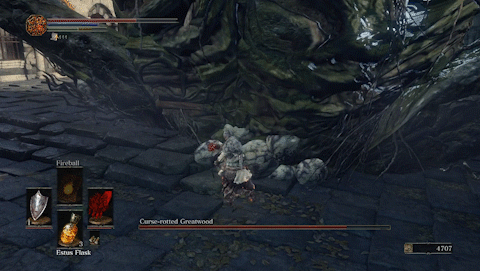 In Hesiod’s version of the myth, Cronus yeets his father’s twin humanities into the ocean, which somehow creates Aphrodite. In DS3, we get to skip the ocean and just straight up get the Transposing Kiln. The connection? The Transposing Kiln is Fillianore’s Egg. Source: https://www.reddit.com/r/darksouls3/comments/690ymv/dragons_crystals_and_transposing_kilns/ https://www.reddit.com/r/darksouls3/comments/690ymv/dragons_crystals_and_transposing_kilns/dh2vthe/ Relevant now, the Mound-Maker covenant is, in part, inspired by the Megapode family of birds who are also known as Incubator Birds or Mound-builders. quote:The birds are best known for building massive nest mounds of decaying vegetation, which the male attends, adding or removing litter to regulate the internal heat while the eggs develop. So the Curse-rotted Greatwood is simultaneously a reference to the tendency of Greek gods to castrate their fathers, and an incubation nest for an egg that will never hatch. And like the reproductive struggle between Uranus and Cronus, then echoed between Kronos and Zeus, Dark Souls is at its core a war to determine who gets to create their chosen world. Oh, and Cronus’ wife is named Rhea, so let’s not pretend FromSoft is somehow oblivious of the implications of the words they’ve chosen to use. Become Nana’s Shade Oh yeah, we also have this weird song from one of the Caged Hollows quote:Another nana disappeared There’s speculation out there that this could refer to the Shrine Handmaiden, tying her in as the Grandmother in Hodrick and Sirris’ story. So let’s work with that assumption because it leads us to a couple of strange places. First, the song opens with “Another nana disappeared.” This means that ‘nana’ could refer to the Shrine Handmaiden, but she would be ‘a nana’ and not ‘(the) nana,’ because there would have had to have been another nana before her. Second, the idea “become nana’s shade,” could potentially therefore suggest a process of replacement and that there will be another nana after her. An eternal cycle of recreation. And thirdly, another way to rephrase the closing is to become nana’s shadow. What connection might that lead us to?
|
|
|
|
It has been a long time since I was excited to see updates in a thread. I absolutely love the work you've been putting into this. It certainly has me looking at the Soulsborne games in an entirely new light. I'm not sure I've ever seen such an in-depth analysis on the settlement. Most discussion I've seen brushes it off with "just another place where hollows are sent for torture/dismemberment/repose." I also appreciate the examination of all the vegetative stuff going on. It was such a weird visual throughout DS3 that just doesn't get enough attention. Also, holy poo poo at that comparison between the egg and transposing kilns.
|
|
|
|
Mutant Headcrab posted:It has been a long time since I was excited to see updates in a thread. I absolutely love the work you've been putting into this. It certainly has me looking at the Soulsborne games in an entirely new light. Thank you! I'm glad it's so appreciated! One of my favorite parts of egg/kiln reddit chain is the response. "As cool as this is, I'm pretty sure it's just reused art assets in a piece of (inherently non-canon) concept art." "inherently non-canon" -- I love it when reddit posters are so confident while being so wrong.
|
|
|
|
Sibyl Disobedience posted:My belief is that the Evangelists are here to oppose the religious system that has sprung up around the Curse-Rotted Greatwood. Sibyl Disobedience posted:Assumption #5: The wagons we see are for corpse trafficking
|
|
|
|
Blaziken386 posted:They're also frequently seen saying "Cleanse this bastard's curse." Them being anti-tree makes sense, in that regard! Yeah. These games have a wonderful way of messing with our linguistic expectations, and technically asexual reproduction is being born out of wedlock. It also makes it even funnier if Allfather Lloyd was considered a derivative fraud because all his creations were genetically identical. quote:Since this whole LP is very much poking at the ties between FromSoft games, I feel it's pertinent to mention the very similar wagons in Yahar Gul, which were used to transport people in for experimentation. They are! But Yahar'gul isn't the first time the idea showed up!  No, wait. Not that one.  No, not that one either.  There we go.
|
|
|
|
Episode 17 (DS3-06):A crow in his cageCornyx of the Great Swamp (DS3) posted:Ah-ha, Unkindled are we?  The Road of Sacrifices plays a major role in the introduction of Irina and Eygon as well as Anri and Horace. But those stories are complicated and I want a low effort topic because I’m wasting all my free time on Hades, so let's talk about Corvians. This area introduces us to the Corvians as the apparent escapees of a sacrificial caravan, but there’s something weird about them. They look nothing like the Corvians we find in the Painted World of Ariandel. 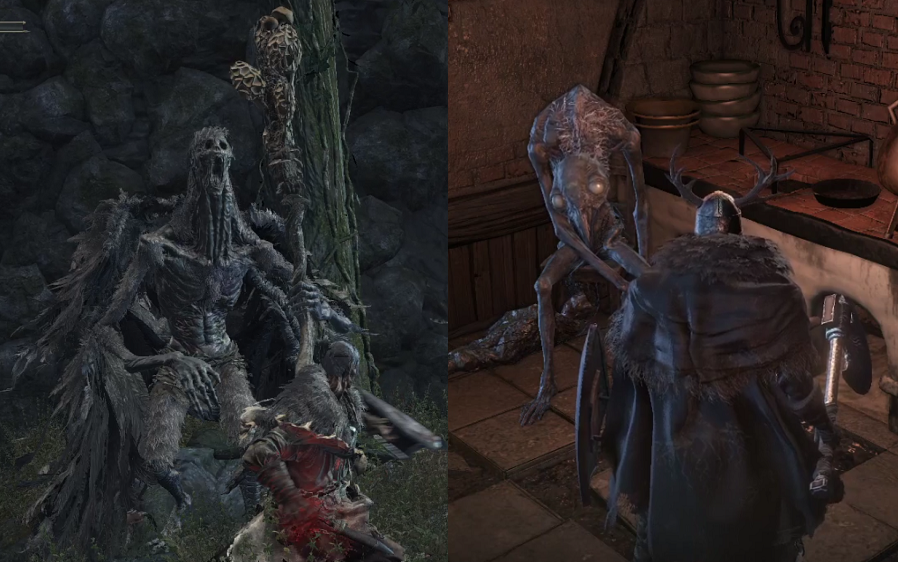 Design-wise it’s essentially like their human-like components have flipped. This is most obvious in the differences in faces and wings, but it’s also exhibited in the legs and feet. The Road of Sacrifices Corvians resemble the Crow Demons in the Painted World of Ariamis in Dark Souls 1. The Ariandel Corvians’ design is first seen in the denizens of the Valley of Defilement in Demon’s Souls, hints of which show up in the faces of the ghouls of Blighttown in Dark Souls 1. I’m inclined to interpret this as another example of diverged realities in the broader Souls universe. Hence each type of Corvian having its own Painted World, as well as both species using Pyromancy but one exhibiting Fire Pyromancy and the other Poison. Trying to piece together the story of their races would require looking at all of their appearances, which would require visiting the Painted World of Ariandel, Farron Keep, Demon Ruins, arguably Irithyll, the Grand Archives, and the Untended Graves. That’s well beyond my scope today, so let’s focus on their two apparent leaders: Cornyx of the Great Swamp, and Ariandel. Calling Cornyx a Corvian might be a controversial claim, but let’s look at the hints provided. He’s caged in the Undead Settlement, an ideal holding spot for someone who is to be sent on the Road of Sacrifices. He teaches pyromancy, a magical school heavily associated with Corvians in DS3. His shoulders have dark feathers similar to the ones we later see both in the design of the Road of Sacrifices Corvians and Father Ariandel himself. And finally, we have his opening dialogue where he refers to himself as “a crow in his cage.” The question then if he’s a Corvian, why does he not look like one. My less convoluted theory is that he’s not yet a Corvian. These statues in the Cathedral of the Deep hint at a process of evolution between human and Corvian.  The problems with this theory are: 1. It suggests that the Road of Sacrifices is shipping people to the Cathedral of the Deep to get transformed, yet Cornyx already identifies as Corvian prior to this occurring. 2. The Cathedral of the Deep statues display both a beak and wings, and as we’ve already shown neither type of Corvian in the game exhibits both. My more convoluted explanation is that the point of view you inhabit in the Undead Settlement is a Corvian. As a result Cornyx just looks normal, which for you as a player means visually coding him as a human. It’s a particularly nasty trick that I wouldn’t put past FromSoft. I’d probably never suspect it if it weren’t for some peculiarities around the Amygdala in Bloodborne. Beyond that, we don’t really know much about Cornyx. The more immediately interesting figure is Father Ariandel. 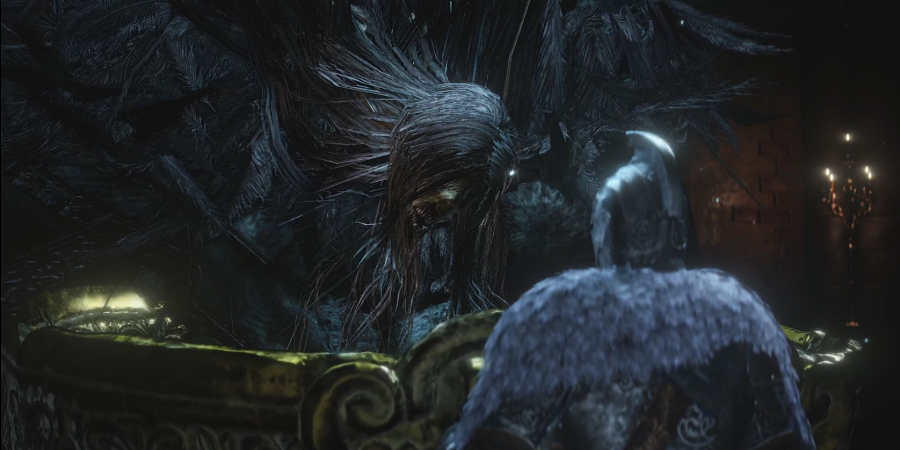 He shares Cornyx’s feathered shoulder motif, though oddly his face resembles the Road of Sacrifices Corvians more than the Corvians found in the Painted World. It’s almost as if the current Painted World inhabitants are new creations serving under the patriarch of the previous inhabitants. Ariandel is arguably a practitioner of pyromancy, given his whole schtick with throwing his flaming soup bowl all over and setting the room on fire, so let’s talk about the connection between pyromancy and birth. Cinders of a Lord, Twin Princes (DS3) posted:The Lothric bloodline was obsessed with creating a worthy heir, and when this proved impossible, resorted to unspeakable means. The first major pyromancy ritual we encounter in Dark Souls is the Bed of Chaos, and the Bed of Chaos is an artificial uterus. The connection between pyromancy and birth is also quite possibly something Cornyx hints at if you read between the lines: quote:But I regret to say, I cannot accept this. Another example of pyromancy as a means to give birth shows up in the chamber of the Demon Firesage of Dark Souls 1. 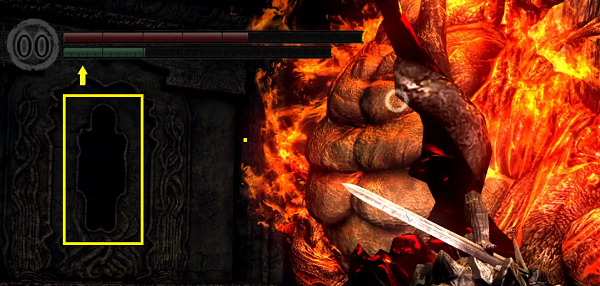 These peculiar human-shaped holes cover the room, and I expect are meant to imply that the demons are using pyromancy to create golems, similar to the conceit found in the Chamber of Birth of La Mulana.  As I’ve pointed out elsewhere, the intro movie for Dark Souls 1 shows the Firekeeper of Firelink Shrine using embers to apply the Darksign and reanimate the dead, another example of fire manipulation being used to create life, or in this case rebirth the dead. So with that said, I suspect the Bed of Chaos is symbolically meant to represent to rebirth an important figure. According to the DS1 Design Works Interview: quote:Otsuka: It seems you designed King Izalith at one point too, what was that like? Either King Izalith would have been “using” the Bed of Chaos in an attempt to procreate, or he would be reborn out of the Bed of Chaos. Possibly both at different stages of development. Possibly both simultaneously. But given the conclusion of Sekiro the idea of using pyromancy to rebirth a dying king was likely something they conceived of at some point in the development. And if you think about it, phase two of the Soul of Cinder fight is essentially fighting Gwyn again at his prime, complete with a reprise of his boss music and with the Soul of Cinder fight finally including the lightning bolts we saw in the opening video of the entire series. And that brings us to Ariandel, because phase two of the Sister Friede fight invokes the very same theme, with Ariandel using flame to resurrect the dead. One of the themes of Dark Souls is that it is literally a mish-mash of everything. It isn’t inspired by one particular mythology; it uses any myth it can get its hand on. Effectively it’s like the Curse-rotted Greatwood: a nest composed of abandoned trash. The trading crows found in every game of the series is another invocation of this idea, collecting your discarded garbage to build their nests. So since we talked about Cronus and Greek myth last time, let’s bring Welsh myth into the fray. Because Ariandel’s cauldron is almost certainly meant to remind us of the Lordvessel from Dark Souls 1, and I suspect both are inspired by the Pair Dadeni, the Cauldron of Rebirth. In the myth, the Pair Dadeni is used by the Irish to revive the dead, a parallel similar to the manufacturing of the undead curse hinted at throughout the lore of Dark Souls. It is finally destroyed when one of the characters in the story “hides among the Irish corpses and is thrown into the cauldron by the unwitting enemy. He destroys the cauldron from within, sacrificing himself in the process.” I suspect this is the inspiration for Slave Knight Gael and his role in the Ringed City. That said, the more interesting mythological tie for Ariandel specifically is the Raven god of Native American traditions, possibly specifically of the Haida peoples of the Pacific Northwest, but since there are so many iterations of the Raven god and Dark Souls draws from so many different sources it can sometimes be hard to nail down one particular source. So let’s lay out the thematic links for why I believe this is the case. 1. The Transposition Kiln The Raven god is a trickster who “never actually creates anything; he made the world by stealing, exchanging, redistributing, and generally moving things around.” Hence, we have the Transposition Kiln as a magical object that creates explicitly via moving things around, as well as the idea of Allfather Lloyd as a “derivative fraud.” Lloyd’s Sword Ring, DS3 posted:Much time has passed since the worship of Lloyd was common in the Way of White. The clerics of Carim had always strongly asserted that Lloyd was a derivative fraud, and that the Allfather title was self-proclaimed. This would certainly be an apt description of a god only capable of moving around the creations of others. 2. The missing Sun and the absence of water “One version of the Raven creation story is that of the Cahto in California. In one variant, Raven is taught by his father, Kit-ka'ositiyi-qa, to be a creator, but Raven is unsatisfied with the result. He creates the world but is unable to give it light or water. On hearing that light could be found hidden in a far-off land, Raven decides to travel there and steal it.” As I have pointed out, Dark Souls 1 in particular is missing water everywhere. It’s also missing a genuine sun, with the heavy implication that the sun goddess we see is illusory. The idea of the Raven then going to steal someone else’s sun is rather reminiscent of the story of Vendrick in Dark Souls 2: quote:Seeker of fire, conqueror of Dark. 3. The themes of Stone Dragons and Tree Giants quote:Ravens have a significant role in the creation legends of many different Native American tribes. According to the Haida tribe of the Queen Charlotte Islands, Greater Raven was the creator that first called earth into being on the endless sea. He then made humans out of both rock and leaf. The people of rock were (as I can well imagine) more difficult to shape and were never finished.  quote:The people of leaf, on the other hand, were quickly completed and ready to roam the land. The raven instructed them that, like the leaf, they must eventually fall and rot back into the earth and thus death entered the world. 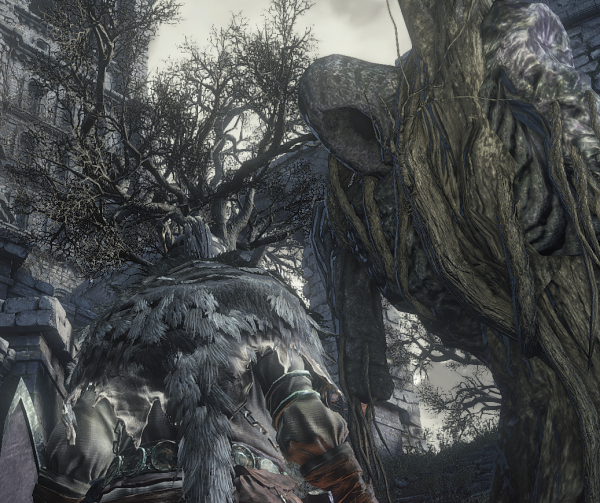 4. The White Feathers Concluding back with a return to Greek mythology. quote:Apollo, the son of the most powerful greek God Zeus, had an important, albeit tumultuous relationship with crows. The greek word for crow, corone, comes from the name of Apollo’s mistress, Coronis. According to the version of this story told by Appolodorus, although Coronis and Apollo had been lovers, she left him to marry a mortal, Ischys. The crow, then white, brought news of the marriage to Apollo who became so incensed he burned the bird’s feathers and then burned Coronis to death. But there is a Haida variant of the same concept: quote:Long ago, near the beginning of the world, Gray Eagle was the guardian of the Sun, Moon and Stars, of fresh water, and of fire. Gray Eagle hated people so much that he kept these things hidden. People lived in darkness, without fire and without fresh water. Isn’t it curious that if you look at the starting gear for the player’s pyromancy class shown above, the shoulders look a lot like Ariandel’s, with the exception a silvery white? (There’s also some bits about Raven creating humans from clam shells, which might explain the origin of the peculiar clam enemies in Crystal Cave and Ash Lake of Dark Souls 1.)
|
|
|
|
Another Raven/Crow from myth, which may or may not be important: Yatagarasu, the Herald of the Sun (or, given Solaire's failed quest, Yatagarasu's absence?) ...who I know about entirely because of Touhou, but that's beside the point! 
|
|
|
|
In terms of themes, there's also the parallel that the demons of Dark Souls 1 and the giants from Dark Souls 2 are both associated with trees (or at least tree-like growths, in the case of the Bed of Chaos). The few creatures in DS 2 that are called demons are quite different and don't have a common origin; it seems to me that they're only called "demons" in a derivative or metaphorical sense. The giants' role in the backstory of DS 2 is also similar to that of the demons in DS 1: A group of powerful nonhuman creatures that the king of the land defeated in a past war. Of course, the causes, events and outcomes of those two wars are quite different, and comparing them might actually lead to a lot of interesting insights into the characters of Gwyn, Vendrick and their respective kingdoms. For instance, the war against the giants explicitly wouldn't have happened without Nashandra's influence, while Gwyn's wife is never even mentioned (I've seen a theory somewhere that Gwyn's wife might have been Velka, associated with crows, fittingly enough); and the army of Drangleic that actually did the active fighting is fleshed out quite a bit while the Silver Knights are mostly an extension of Gwyn without much agency of their own (at least until the Ringed City with its tidbits about Silver Knight Ledo). In fact, from the way they're presented and even from the game worlds they supposedly took place in, the war against the demons feels more like a myth while the war against the giants feels like a historical event. By the way, in case you haven't seen it: Lance McDonald has managed to restore enough of the cut Northern Limits area from Demon's Souls to show off what the place was supposed to look like and how a player would have traversed it. Since the area looks quite similar to the Painted Worlds, it might be relevant to your interpretation.
|
|
|
|
Thank you for the leads both of you. Things like that truly have a tendency to end up helping in unexpected ways. The absolute layering of references and metaphor in this series is absolutely insane. It's not super developed, but I actually think that both the DS1 Painted World and the Lost Bastille are metaphysical references to that cut Demon's Souls area, though I haven't fully developed that theory out. Another one of my theories undergoing betatesting is that the player progression in DS1 is a coded version of Vendrick's story, with the first bell representing the taming of the dragons for Drangleic, the second bell representing the discovery of Nashandra, and the Lordvessel being the object he stole from the giants. It's still not completely fulfilling to me, but Soulsborne is playing a lot of tricks via shifting its point-of-view and symbolism. Some particular event might be either a myth and a historical event depending on the perspective you're observing it from. I've been kinda slacking lately, but I'm trying to put together a big video for the DS2 "playthrough" because DS2 is the clearest example of how the symbolism within the game progression has its own coded narrative. I'm also trying to figure out some ways to I guess advertise this outside of SA or maybe fix my Youtube SEO. I crave more people to talk about it with because that chaos always brings new ideas, but finding that can be hard because this process isn't easily approachable. In the meanwhile, next text episode is going back to DS1 for Darkroot Basin, hopefully this week if I can pull myself away from Hades. I also finished playing Hollow Knight again for someone this weekend, and my current wildest theory is that it has a secret Dark Souls connection that the devs are actively trying to obscure. All the comparisons between Dark Souls and Hollow Knight focus on the gameplay and setting, and all of that could easily be superficial or coincidental. It's their narratives that echo in impossibly specific ways. quote:Mrmm. You came. quote:Within my roots, the weakening of the Vessel I plainly feel. Only two obvious outcomes there are from such a thing. quote:Ahhhh, you've returned. Welcome back to the waking world. The true sin is always forgetting.
|
|
|
|
Sibyl Disobedience posted:The absolute layering of references and metaphor in this series is absolutely insane. Indeed. When I wrote my last post I originally just wanted to mention the Lance McDonald video, but thought it would be impolite not to at least comment on something from the update; I decided to talk about how curious I find the giants' tree motif; and then the parallel between the demons and the giants and everything following from it, which I had never noticed before, became immediately apparent when I thought about it on a thematic level for a moment. I've said it before, but there's just such a dearth of thematic and structural analysis for these games, even though their way of storytelling almost demands that sort of analysis. The Soulsborne games kind of had the misfortune of being released in an epoch and to an audience that's mostly used to treating artworks (videogames in particular) as basically nonreal realities that have an independent and potentially expandable existence outside of what's shown of them in the actual work, and not as constellations of themes and characters that exist first and foremost to fulfill a specific role within the work itself. That always reminds me of this Twitter thread from the developer of Night in the Woods. In any case, it's probably not a coincidence that Dark Souls' gameplay has more-or-less created a whole genre, but there've to my knowledge only been very few attempts to imitate its narrative structure.
|
|
|
|
I don't have much to add to the conversation, I just wanted to stick my head in and say I'm loving this LP, and you're doing great work with it.
|
|
|
|
Vandar posted:I don't have much to add to the conversation, I just wanted to stick my head in and say I'm loving this LP, and you're doing great work with it. Thank you so much. I really appreciate posts like this, and if you do ever have anything you want to add or ask know that it's very welcome. Every new soul allows the abyss the spread a little further. Carpator Diei posted:I've said it before, but there's just such a dearth of thematic and structural analysis for these games, even though their way of storytelling almost demands that sort of analysis. The Soulsborne games kind of had the misfortune of being released in an epoch and to an audience that's mostly used to treating artworks (videogames in particular) as basically nonreal realities that have an independent and potentially expandable existence outside of what's shown of them in the actual work, and not as constellations of themes and characters that exist first and foremost to fulfill a specific role within the work itself. That always reminds me of this Twitter thread from the developer of Night in the Woods. In any case, it's probably not a coincidence that Dark Souls' gameplay has more-or-less created a whole genre, but there've to my knowledge only been very few attempts to imitate its narrative structure. The funny thing about this is that Dark Souls is actually the perfect example of puzzle-box literature if you're willing to throw away your assumptions and adopt a new set of rules. If you're not, it's literally unsolvable. Any consistent explanation of the games will be incomplete, and any incomplete explanation will eventually be inconsistent! It's such a gorgeous specimen! But Dark Souls (and Bloodborne) are designed in such a way that they're very much intended to look like they could be solved literally at first glance. Convincing people to try to write their own stories is part of the goal! (The other part is probably that you'd get more "The Earthen Peak elevator can't be going up" complaints if you don't take the steps to conceal your treachery) But it gets frustrating is people try to make lore explanations that are hyper literal and "make no assumptions." It's like, bitch if you're using an item description you're already making the assumption that every item description is an axiomatic truth! Good logicians use assumptions to test their hypotheses about the world. Bad logicians pretend their axioms aren't assumptions, and then complain the moment you theorize any of their precious axioms aren't the complete and absolute truth. It's ultimately a slightly different dynamic than Scott Benson is describing, but you're right that it does likely come from the same place of people wanting this elaborate (and importantly knowable) universe for their media. And that's at odds in a weird way with Dark Souls because it's not precisely about an unknowable universe so much as it's about a universe that's in the process of being forgotten. On another fantasy lit recommendation from the same person who brought up the Coldfire Trilogy, I've been reading The Hollowing by Robert Holdstock. And yeah, I picked it out solely because of the title. I really do suspect that an absolutely tremendous amount of literary sources were processed by the collective mind creating these games, and it's honestly been a joy to try to hunt down the connections and reverse engineer the process. Anyway, whether or not my suspicions on this book are correct, I was delighted to find a description that perfectly encapsulates how I view the various universes we encounter in Dark Souls: quote:“Because this is a dying place,” Lacan said coldly. “We made it so when we built the Station. We made it so when we set up the protective field to keep ourselves apart from the wood. These mythagos, these helpless creatures, are drawn here, drawn to us, and the closer they come the more their lives are drained. You must remember something: they are just dreams. Like dreams, they seem so real for a while, and then they disperse and are soon forgotten. Harden your feelings until you can understand better.” In the book (or at least my understanding at this point, I'm only half done), mythagos are the creatures and characters of myth given corporeal form by the dreams and memories of the outside world. As best I can tell, they only know how to relive their mythical stories and lack any form of agency beyond that. Dark Souls is basically the same thing. A dying place composed of the memories of myth struggling to survive. This is most literally conveyed with the Ashen Mist Heart, but I think the only difference between those interactions and the bonfires we use are which layer of memory we're operating on. And speaking of trees: quote:“Do you not get it yet? Everything you see is Huxley. The wood was here from the first seed after the ice, yes, of course. And people came and went and seeded the wood with the products of their myths. Yes. Yes. But not until Huxley was it shaped. Whatever the man did, he touched its very heart. Huxley is dead, but lives on around us. We are living in the man, in the mind of Huxley himself. And somewhere out there, somewhere at the heart, is the key and the clue to what he did, thirty years ago. But Alex… Like Huxley here, Aldia has kinda become a forest, an refuge where he cultivated and preserved what he could (which would incidentally be the same goal Seath has with his crystal golems). In the Blighttown video I mentioned the idea of the Kos Parasite/Doll being a tumor on Gehrman's mind, so seeing that metaphor brought up in the book was a delight. But I want to draw attention to something about Aldia Dragon Acolyte Mask posted:Helm worn by acolytes of Aldia. Note the use of the phrase "in Aldia" not "in Aldia's Keep." By itself this is relatively innocuous, but if you'll remember, Bloodborne pulled the same curious phrasing with Oedon! Oedon Tomb Key posted:Key to the gate that blocks the Tomb of Oedon. I think a huge part of the implicit design inspiration for these games, in particular DS2 and Bloodborne, are that we're literally inside a living creature, and typically an infested one. The bell maiden in Yahar'gul are a viral infection that the Amygdala are trying and failing to filter. The Lecture Building has a centrifuge that is trying to remove the blood clots that are the slime scholars. The entire theme for the Loran Chalice is that you're inside of a brain, hence the lightning synapses pulsing through the walls. And the sun in the Nightmare is an eyeball. On that note, I have a weird theory that Dark Souls 2 is an inversion of Bloodborne in which you, the player, have no insight. Given that, one of the fun implications for Lucatiel being inspired by Don Quixote is this: if Don Quixote mistook a windmill for a giant, what would happen if we mistook a giant for a windmill? Oh, and about the Northern Limits area, two things stood out to me. First, the avalanche they showed was replicated in DS3's Painted World. It's not too surprising; refurbing abandoned set pieces is FromSoft's MO. Second, that final, ovular boss arena they show off. My hunch is it was going to be an egg. Can't let Earthbound be the only video game that ends with an abortion. On that note, it stands out to me how much the Nexus resembles DS3's Firelink shrine, a similarity I strongly suspect was an intentional one. But one thing I'm now wondering is if both areas are symbolically tied to the Bed of Chaos, with Yuria and Irina being located where the ovaries are that you need to destroy to open the path to the center of the area. The idea that the main plotline of DS3 is the Firekeeper eternally trying to complete the Bed of Chaos ritual until you can show her that it's a lost cause has a certain poetic finality to it. It also offers an explanation between that certain parallel between the endings of Demon's Souls and Dark Souls 3. Oh right! It completely slipped me mind that there was another reason I brought up The Hollowing. In the book, the introduction of the teenager into the wood of Huxley causes a sort of corruption in the mythagos process. Instead of being pure myth, the things Alex produces are a merger of the stories he knew and the things he liked. quote:Alex is creating oddities, combinations of passion and myth. The example the book uses is a mixture of a green-bearded giant from an Arthurian tale and a dinosaur. It's a conceit that's eerily reminiscent of Sulyvahn, where the eyes he gives out to his knights gradually turn them into beasts. It's also similar to FromSoft's design process as a whole, where later bosses in the series are transparently evolutions and mixtures of entities from previous games, so it's exactly the kind of meta-metaphor that I suspect they'd love. Sibyl Disobedience fucked around with this message at 00:26 on Oct 14, 2020 |
|
|
|
I was going to make a joke here about how you'd tie in a pregnant person's water breaking with regards to Yharnam, pthumerian queen and how water in general is absent or obviously leaving the world. But I guess that makes sense if you pretend embryonic fluids is water 'leaving' an 'area', to speak metaphorically. Eurgh. Hmm. Anyways, thank you , this is a fantastic read and I appreciate someone delving into the details, making some conjecturing. It's a shame and a relief most of the fan wikis are very bare on this type of stuff. I'm not sure I can handle 'silent hill circumsition part 2 feat BloodSouls', personally.
|
|
|
|
value-brand cereal posted:I was going to make a joke here about how you'd tie in a pregnant person's water breaking with regards to Yharnam, pthumerian queen and how water in general is absent or obviously leaving the world. But I guess that makes sense if you pretend embryonic fluids is water 'leaving' an 'area', to speak metaphorically. Eurgh. Hmm. Well, funny you should mention that... https://i.imgur.com/gWwpF7L.gifv And if we go immediately outside of the Advent Plaza where we fight the One Reborn we have this scene:  They were trying to climb to higher ground as if they were hoping to outpace a rising liquid. Also want to point out that similar to the Bed of Chaos we have the same tree root imagery along the walls of the square.
|
|
|
|
*crosses legs* Ah ew hm! Well I am glad the game devs did think of everything! That's genuinely interesting and unexpected!!
|
|
|
|
Something different, mostly because I think it's neat: There's an interesting graphical overhaul mod for Dark Souls 2 in development, called Flames of Old. The developer's Twitter has a bunch of preview screenshot, though the mod probably won't be finished for quite a while. The dimly-lit areas look particularly impressive. Between this and the Demon's Souls remake, it will be interesting to see how visual tweaks affect the atmosphere of these games, especially with regards to subtle things like lighting and colour.
|
|
|
|
value-brand cereal posted:*crosses legs* Ah ew hm! Glad I could brighten your day! Carpator Diei posted:Something different, mostly because I think it's neat: There's an interesting graphical overhaul mod for Dark Souls 2 in development, called Flames of Old. The developer's Twitter has a bunch of preview screenshot, though the mod probably won't be finished for quite a while. The dimly-lit areas look particularly impressive. Between this and the Demon's Souls remake, it will be interesting to see how visual tweaks affect the atmosphere of these games, especially with regards to subtle things like lighting and colour. I'm probably a bit of a heretic on this point, but I'm really glad FromSoft has moved away from that kind of atmosphere. Playing through Latria 3-1 right now, and I'm not really finding it spooky at all, just tedious. Like, eyestrain tedious rivaling Lost Izalith. I've seen people describe it as a neon mess, but I find Irithyll to be that perfect sweet spot between ethereal fae beauty and collapse of civilization creepy, and a lot of the area designs in the same time frame are awe-inspiring, especially Archdragon Peak and Fountainhead Palace. I think there's just a lot more impact for me when something beautiful has become ruined (or has become beautiful because of the ruining, like a nature reclamation process), than the more oldschool grimdark dungeons all the time that was prevalent in the older games. But to be fair, a lot of that probably stems from hardware and budget limitations at the time.
|
|
|
|
Sibyl Disobedience posted:I'm probably a bit of a heretic on this point, but I'm really glad FromSoft has moved away from that kind of atmosphere. Playing through Latria 3-1 right now, and I'm not really finding it spooky at all, just tedious. Like, eyestrain tedious rivaling Lost Izalith. Yeah, I agree. In my opinion there are some areas where that early-Souls visual style of floaty vagueness works rather well (such as Darkroot Garden, the Chasm of the Abyss, and some parts of the Boletarian Palace), but also areas where it doesn't look all that great (Lost Izalith, Shaded Woods etc.). And Fountainhead Palace definitely has some of the greatest visuals in any of these games, especially because the look of the area actually conveys meaning (down to fine details like the cherry petals that cover the buildings like mildew). Though to me the most beautiful single moment has to be the flight to the Ringed City.
|
|
|
|
Episode 18 (DS1-08): It's just that, I wish to know the truth.quote:There is not a contradiction. The lore of Artorias that prevailed in the original story is very old, so that it is uncertain. Hence by experiencing the story of the additional content there's a partial view of new facts, and the newly unveiled lore will show players another dimension. I suppose this is what lore is like and why it is attractive. Darkroot is really, really weird. Why is any of it even there? Why is the DLC entrance in such an obscure, out of the way place? So now that we’ve arrived in the prime anomaly, let’s talk about how, from an authorial perspective, Dark Souls is indisputably metatextual. quote:Isomura: Dusk of Oolacile's summon sign is pretty hard to find, even though she says where it will be. Does she actually want to be summoned or is she trolling us? She says she wants to reward us, but is she laughing behind our backs? You see, Darkroot and Oolacile are cut content. The remnants of a scrapped prototype whose creator couldn’t bear to just flush down the drain. We first enter Darkroot Garden when we get past the Titanite Demon in the room next to Andre. This symbolizes getting done with Demon’s Souls. We then have three different layers of Darkroot, two floors of Basin and Garden itself. In my head, I associate these with the three original planned names for the game, Dark Race, Dark Ring, and Dark Lord. Dark Race was going to be something oriented around gaelic fae and Norse/Germanic Ring of the Nibelung dwarves. It was going to feature the ruin restoration mentioned in the interview, and is likely the source of the Gyrm model we find in DS2 (and probably also responsible for concepts like the Rat Covenant). I also suspect that Nito in his originally flaming form was somehow associated with this iteration of the development (although he alternatively might have been a Demon’s Souls reference of sorts). But ultimately, the scope of this idea was infeasible. The fae aspects remained in Dark Ring, as exhibited by the Moonlight Butterfly found in the middle floor of Darkroot. My reasoning for this is that Moonlight Butterfly shares a theme with Gwyndolin, and Gwyndolin’s name translates to White Ring in Welsh. My anticipation is this would set Gwyndolin as the “villain” furious that her world was destroyed in the abandonment of the previous prototype. The "White Ring" turning into the "Dark Ring." For whatever reason, this prototype direction didn’t pan out either. Dark Lord ties into Darkroot Garden proper, Artorias, and the upper layer of Oolacile. My suspicion is that this storyline would have been inspired by Arthurian legend. Hints of this include the name Artorias itself, Latin for Arthur, and the inclusion of Seath’s Crystal Cave, very deliberating invoking Merlin. A potentially far more obscure reference is Marvelous Chester. I’m certainly willing to consider this a leap in logic too far, but I suspect Chester is a reference to the city of Chester in Cheshire England, and more specifically the Chester Roman Amphitheatre. In 2010, shortly before the 2012 release of the Artorias of the Abyss, there was speculation that the Chester Roman Amphitheatre was the location of King Arthur’s Round Table. Other historians have disputed this claim, but when you’re making your own myth it’s not particularly important whether the inspiration actually happened or not. An amphitheatre is a reasonable description for the arena where we encounter Artorias. I suspect this development direction was plausibly achievable, unlike the previous two prototypes, but beyond FromSoft’s reach financially at the time. Hence, we have the hefty soul cost on the Crest of Artorias needed to enter the front gate. Of interest here, Bloodborne echoes this same setup with the Hunter Chief Emblem, and interestingly enough, shortly after using the Emblem we arrive at what I now like to describe as a massive headstone for a round table (a motif replicated outside of Gwyndolin’s boss room in Darkmoon Tomb, interestingly enough). 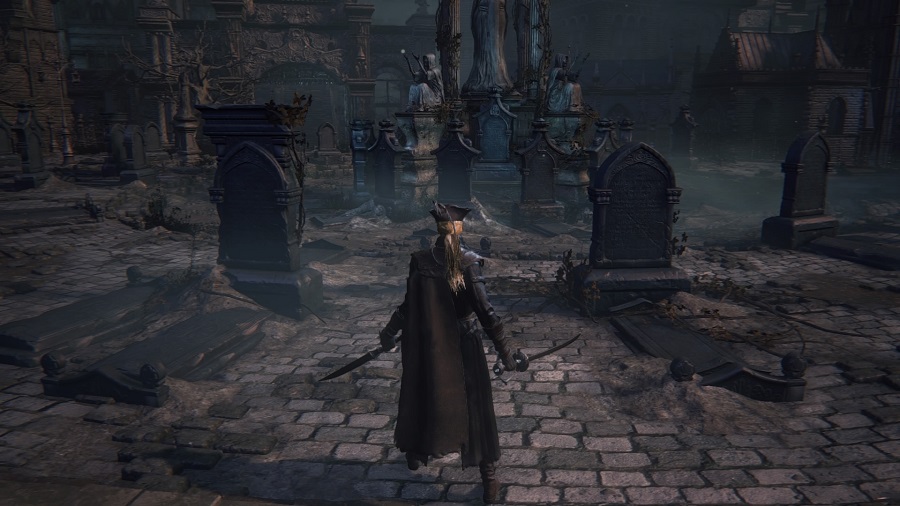 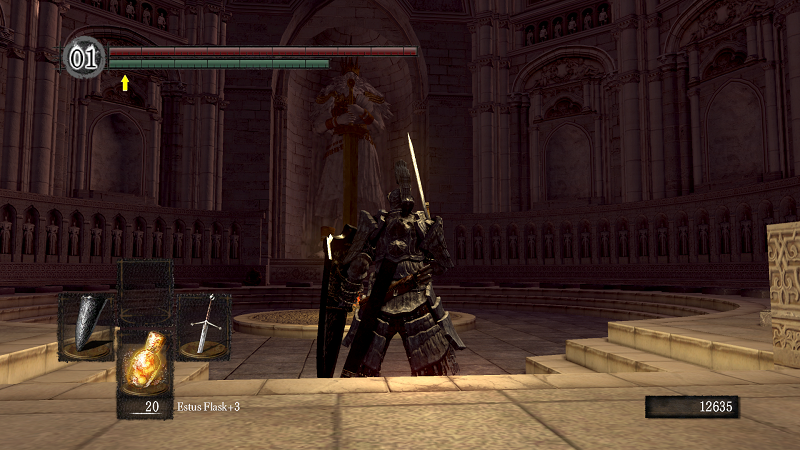 My expected general plotline is that Arthur had fallen asleep in a Fisher King sense, and the kingdom was freezing over due to his absence. Meanwhile, his knights had carved out their own niches from the kingdom in plots revolving around kidnapping, organ harvesting, and slavery. Your goal would be to slay his four strongest successors as part of a grail quest to free the world from Arthur’s ruined legacy. Chester would ultimately be a nod at these themes getting absorbed into Bloodborne instead where they found a much more natural home. Remnants of the idea still exist in Dark Souls 1, such as the Channelers predilection for kidnapping. Of particular relevance is this bit from the Dark Souls 1 Design Works Interview: quote:Miyazaki: Smough came from the initial concept stages, while Ornstein was introduced much later. I remember the channeller's design was put forward around the same time as Smough's and we all took to referring to them as the four knights, knights C and D if I remember correctly. I hoped that by doing this it would ensure that knights A and B were created. Haha. FromSoft, and in this case probably Miyazaki specifically, never completely abandon cut content. They recycle. For me, this makes these games kinda like a fossil record. You can actually observe an evolutionary history of the design process if you look closely enough. But a lot of this intensely speculative, so let’s get back to only mild speculation. We know from the above interview that the Painted World of Ariamis is a “prototype map”. We also know that the Painted World is the home of the forlorn, “those with no place to call their own.” Hence, the Painted World is the land of cut content that Miyazaki couldn’t bear to just abandon. I’d further speculate that the Painted World is the original Ringed City, a fae city you would travel to via a mushroom circle, hence, “ringed.” Home of the pygmies (the “dark race”) because, being a fae city, you would shrink yourself down in order to enter it. Consider this weird bit of parallel symbolism. 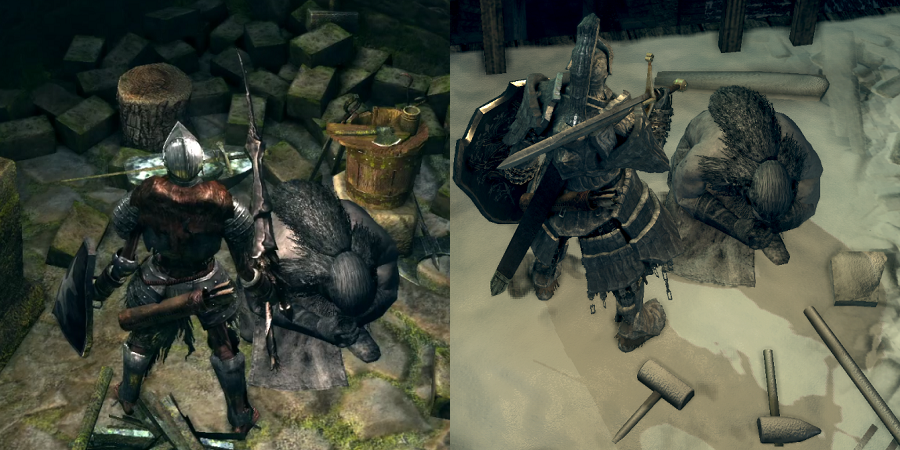 The same petrified blacksmith motif is replicated in both the area after you fight the Moonlight Butterfly and the Painted World, and in each area you find an ember, Divine for Darkroot and Occult for Painted World. It’s yet another choice between light and darkness, just like the Gwynevere and Velka coded chests in Sen’s Fortress. It’s as though something happened at Oolacile, in both the narrative and metanarrative, that caused the world to branch into light and dark realities. Frampt’s vision of how to precede and Kaathe’s. But putting all that (mostly) aside for now, there’s one stretch within Darkroot Basin that I remain absolutely fascinated by:  This. Area. Is. Important. Nothing about this space makes sense. It’s geography. The DLC questline. I’s enemies. None of it makes sense in any obvious way. This means it must make an incredible amount of sense in some non-obvious way. For example: 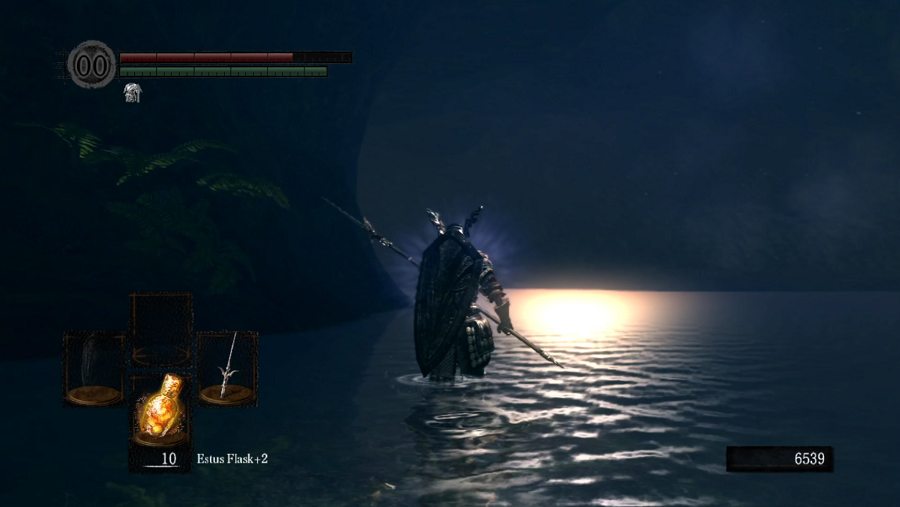 This reflection at the entrance of the cave where we find Dusk trapped in a Golden Golem and then return later to enter Oolacile should not exist. There is no physical way for what appears to be sunlight to be reflecting off the water here. My first instinct was to just assume that it was a bug, but I’m increasingly unconvinced of that explanation. Sometimes bugs are hard to fix and left in simply because the amount of effort it would take isn’t worth the minimal damage it causes. But this has an easy, obvious fix: you get rid of the cave. You can put the Golden Golem and Oolacile portal anywhere. Their current location is so unimportant to players that putting it literally anywhere else in the zone would have likely been easier for an average, non-internet using player to find. That it exists in its currently immensely implausible state of being suggests that this area is immensely important to someone. A sacred space. A radiance, a gross incandescence worth chasing after. I have two primary guesses for the importance of this cave specifically. The first is that the impossible sunlight reflection reminds me of the Moonside Lake in Bloodborne where you fight Rom the Vacuous. I feel highly confident that there exists an association in Miyazaki’s head between Rom and Dusk. The second is that I could imagine this area being used as a more ancient version of No Man’s Wharf from DS2. This would imply that at one point this lake was a considerably larger body of water, and that the sloped land leading down to the lake at one point constituted a town.  What happened to the townsfolk? Well, Seath tried to preserve them. As I’ve mentioned elsewhere, Seath’s concept art is absolutely, no-doubt-about-it, coded to be pregnant.  Whether this is pregnancy as we usually understand it or something more akin to seahorse males holding eggs is up in the air, but the Crystal Golems associated with Seath’s Crystal Cave and Duke’s Archives areas are also associated with pregnancy because we are told this directly in an interview: quote:Isomura: Dusk of Oolacile and Sieglinde, as they are freed from Crystal Golems, remark that their trap was not uncomfortable. Why does it seem comfortable? It's said that it's cozy in there, but how does it really feel like? So the golems are clearly implied to be a sort of rebirthing process here, but it also suggests a cryogenic stasis. Essentially, Seath is trying to set up a sort of nature preserve, with the end product of his efforts being the moonlight butterflies we see throughout his Crystal Cave. The question then remains: why was it important to have a harbor underground? Shifting away from narrative elements in favor of more purely practical concerns, my speculation on this point is that it would have been a way to divide up a town area in order to avoid performance hitches. By using a rock wall to divide the areas you can deliver a seamless gameplay experience while only having to load and render one half of the entire town at any given time. One guess I have is that the boat the player was intended to take from this port was what eventually became the boat where you encounter the Flexile Sentry in Dark Souls 2, and that Hydra we encounter here and in Ash Lake marks the endpoints of what was to be the player’s voyage. And look, I’m not going to be right about everything here. Filling in a fossil record is going to necessitate a sizable amount of guesswork, and that’s ok. The core theory can easily endure an overactive imagination making an incorrect assumption here and there. But I guarantee you that when it comes to Dark Souls, the narrative and the themes that accompany it possess a self-awareness, and if you want to really understand what’s going on, you need to be willing to probe that abyss. quote:Miyazaki: I wanted to make the old forest bright, and restore the ruins and buildings. So there you would do some quests in Oolacile, getting summoned by Dusk. It's sad, because she's a character I liked so much, so I was thinking about events and quests related to her. quote:I still think on that creature from the Abyss that preyed on me.
|
|
|
|
Hm, they might have tried that world-switching idea again in Dark Souls 3, which was after all planned to have a whole complex world-state system that ultimately didn't get implemented. The closest parallel to Oolacile in the released games is probably the Hunter's Nightmare; though the journey to Drangleic in the intro of Dark Souls 2 is also implied to be at least partly a journey to the past (by entering a sort of portal inside a lake, no less). Probably also relevant for your theory: Darkroot Garden is one of the few places with lots of flowing water, while the river and basin in the Oolacile version are mostly dried up; and the presence of the Hydra connects the basin to Ash Lake, the game's other area with non-stagnant water.
|
|
|
|

|
| # ? Jun 3, 2024 04:10 |
|
Carpator Diei posted:Hm, they might have tried that world-switching idea again in Dark Souls 3, which was after all planned to have a whole complex world-state system that ultimately didn't get implemented. The closest parallel to Oolacile in the released games is probably the Hunter's Nightmare; though the journey to Drangleic in the intro of Dark Souls 2 is also implied to be at least partly a journey to the past (by entering a sort of portal inside a lake, no less). Not only that!  Notice how halfway through the clip the reflection in the lake changes to one where the ruined gate is restored, exactly like what was originally planned to happen in Oolacile! Combing through some of the cut content of DS3 is something I should do sometimes. Some of it is probably due to things not working out, either technically or artistically, but I wouldn't be surprised if sometimes Miyazaki likes to keep things extremely subtle rather than literal. I recall that the world of DS3 was originally supposed to be covered in darkness, but if your character has always existed in that environment, what would we know about the difference between darkness and light? quote:SOCRATES: Imagine this: People live under the earth in a cavelike dwelling. Stretching a long way up toward the daylight is its entrance, toward which the entire cave is gathered. The people have been in this dwelling since childhood, shackled by the legs and neck..Thus they stay in the same place so that there is only one thing for them to look that: whatever they encounter in front of their faces. But because they are shackled, they are unable to turn their heads around.  quote:SOCRATES: Some light, of course, is allowed them, namely from a fire that casts its glow toward them from behind them, being above and at some distance. Between the fire and those who are shackled[i.e., behind their backs] there runs a walkway at a certain height. Imagine that a low wall has been built the length of the walkway, like the low curtain that puppeteers put up, over which they show their puppets  quote:SOCRATES: What do you think? From the beginning people like this have never managed, whether on their own or with the help by others, to see anything besides the shadows that are [continually] projected on the wall opposite them by the glow of the fire. The question for me is whether the direction of DS3 changed from conception to release, or did they just change how they decided to convey it. Consider this really weird dialogue interaction back in Dark Souls 1. Ingward posted:Oh, hello. The sunlight made me wince, and now I've come back to this dark hole! So what brings you here? I will help you in any way I can. This is from Ingward after you get him out of the darkness of New Londo and back up to Firelink Shrine where there's actual. It could be misplaced dialogue, or it could be that what people perceive as "dark" is contextual to their lived experience. And his mentioning that "the sunlight made [him] wince" is also intriguing because quote:SOCRATES: Whenever any of them was unchained and was forced to stand up suddenly, to turnaround, to walk, and to look up toward the light, in each case the person would be able to do this only with pain and because of the flickering brightness would be unable to look at those things whose shadows he previously saw. What was especially delightful was that in the first area I decide to explore in *~*~Demon's Souls~*~*, I came across this Once Royal Mistress (Tower of Latria, 3-1) posted:Before, there were many others trapped here. They've been playing at this for a long time. But we don't have to be trapped below forever with her, because Kos will grant us eyes. quote:SOCRATES: So now, I replied, watch the process whereby the prisoners are set free from their chains and, along with that, cured of their lack of insight, and likewise consider what kind of lack of insight must be if the following were to happen to those who were chained. I've started sharing some selections in the DarkSoulsLore subreddit, and it's mostly gone relatively well. On occasion I've run into a troublesome character in the comments section. For moments like that, I just skip to this passage and cackle: quote:SOCRATES: And now, I responded, consider this: If this person who had gotten out of the cave were to go back down again and sit in the same place as before, would he not find in that case, coming suddenly out of the sunlight, that his eyes ere filled with darkness? I have so much more to say about the dried up Oolacile basin and Kalameet, but I'm trying to keep it to one frenzy proc per post.
|
|
|





